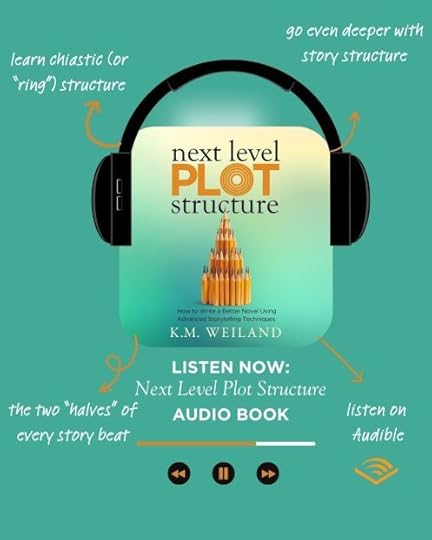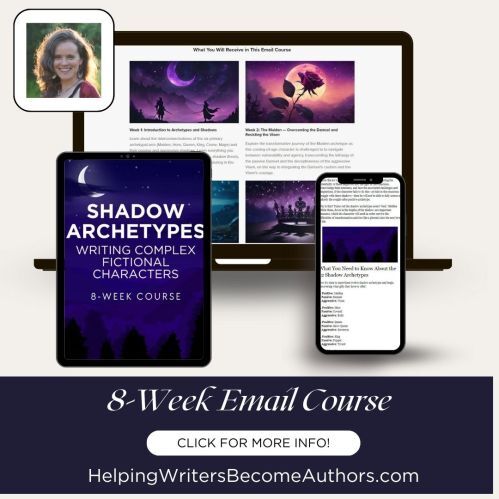K.M. Weiland's Blog, page 2
June 23, 2025
Need a Good Book Editor? Top Up-to-Date Recommendations
 Where do I find a good book editor?
Where do I find a good book editor?
This is without doubt the question I receive most frequently from fellow writers. It’s a hard question to answer because, while finding an editor is easy, finding a good book editor is something else again.
I originally published this resource many years ago after reaching out to trusted writing experts for their recommendations of freelance book editors. I also encouraged readers to share their own suggestions in the comments. Today’s is the latest in a series of updates I’ve made to keep the post current—and I plan to continue revisiting it regularly to ensure the information stays helpful and relevant.
The following editors are in alphabetical order, with their names linked to their websites, so you can do further research to discover which is best suited to your needs. I’ll continue adding to the list whenever an appropriate new name comes to my attention (you can always find the list on the Start Here! page—accessible from the site’s top toolbar).
If you’ve personally worked with a good book editor, please feel free to add his or her name and URL in the comments. (If you’re an editor yourself and would like to be included, please ask one of your satisfied clients to nominate you.) The goal is to make this as useful a resource for everyone as possible. New names will be included in the list when I update it again in the future, so in the meantime be sure to check the comment section for more resources!
The Top Recommended Freelance Book EditorsMarlene AdelsteinServices: Developmental Editing, Publishing Consultations, Screenplay Editing.
Rates: Contact for rates.
Specialties: Commercial Fiction, Thriller, Mystery, Women’s Fiction, Literary Fiction, Historical Fiction, Memoir, and Screenplay.
Affordable EditorsServices: Line editing, proofreading, developmental editing, comic book editing.
Rates: 1¢–1.5¢ per word
Specialities: Science fiction, fantasy, slice of life, historical fiction, memoir, non-fiction.
Services: Developmental edit, editorial assessment, line editing, copyediting.
Rates: Contact for rates.
Specialities: Fiction, memoir, flash fiction, academic articles.
Services: Editing, consulting.
Rates: Contact for rates.
Specialities: Unspecified.
Sally ApokedakServices: Editing, consulting.
Rates: Contact for rates.
Specialities: Unspecified.
Augustine EditorialServices: Developmental editing, copyediting, proofreading, sensitivity reading, beta reading.
Rates: 1.3¢–2¢ per word.
Specialities: Tales set in immersive worlds, stories inspired by S.E. Asian folklore, and slow-burn romantic subplots.
Black Wolf Editorial ServicesServices: Content editing.
Rates: Contact for rates.
Specialities: Unspecified.
Bookaholics Author ServicesServices: Line editing and copyediting.
Rates: Contact for rates.
Specialities: PG-13 material.
Breakout EditingServices: Content editing, copyediting, proofreading.
Rates: 1¢–4¢ per word.
Specialities: Fiction, non-fiction, children’s books, memoir, short stories.
Vicki BrewsterServices: Developmental editing, copyediting, content editing, manuscript evaluation, academic editing, indexing.
Rates: $.50–$1.20 per 100 words.
Specialities: Long-form fiction.
Grace BridgesServices: Line Editing, Developmental Editing, Proofreading.
Rates: $3–$30 per 1,000 words.
Specialties: Science Fiction, Fantasy.
Averill BuchananServices: Development Editing, Copyediting, Proofreading, Indexing.
Rates: £10–£45 per 1,000 words or £1,00–£2,000 per 100,000-word book.
Specialties: Fiction, especially for independent/self-publishing writers.
Burgeon Design and EditorialServices: Coaching.
Rates: $1,200–$6,500.
Specialities: Diversity.
Kelly ByrdServices: Developmental Editing, Line Editing, Copyediting, Proofreading.
Rates: Contact for rates.
Specialties: Crime and Mystery, Thriller, Romance, Literary Fiction, Science Fiction, Fantasy, Memoir.
Sandra ByrdServices: Coaching.
Rates: Contact for rates.
Specialities: Fiction, creative and narrative non-fiction, memoir, devotionals.
Dario CirielloServices: Developmental Editing, Line Editing, Copyediting, Proofreading.
Rates: 1¢–4¢ per word.
Specialties: Science Fiction and Fantasy, Mystery and Crime, Romance, Literary Fiction.
Miranda DarrowServices: Developmental editing, coaching, book mapping, line editing, ghostwriting.
Rates: $.0175–$.0375 per word.
Specialities: Unspecified.
Rochelle DeansServices: Developmental Editing, Copyediting, Proofreading, Manuscript Evaluation, Query Editing, Academic Editing, Non-Fiction Editing.
Rates: Contact for rates.
Specialties: Plot structure.
Christy DistlerServices: Developmental Editing, Line Editing, Copyediting, Proofreading, Manuscript Critique.
Rates: Contact for rates.
Specialties: Unspecified, but seems to lean toward Christian Fiction.
The Engaged EditorServices: Developmental editing, line editing, proofreading.
Rates: Contact for rates.
Specialities: Unspecified.
Joshua EssoeServices: Developmental Editing, Line Editing.
Rates: Contact for rates.
Specialties: Genre Fiction, Fantasy, Science Fiction, Horror.
Elizabeth EvansServices: Developmental Editing, Line Editing, Manuscript Assessment, Proposal Crafting and Editing, Ghostwriting.
Rates: Contact for rates.
Specialties: Unspecified.
Lorna FergussonServices: Developmental Editing, Line Editing, Appraisals.
Rates: £275–£800+, depending on service and length of project.
Specialties: Unspecified.
Free ExpressionsServices: Comprehensive editing.
Rates: $425–$3,875 per 1,000–100,000 words.
Specialities: Fiction, picture books.
Annette M. IrbyServices: Critiquing, copyediting, proofreading, substantive editing.
Rates: $7–$9.50 per page.
Specialities: Christian fiction.
Don JanalServices: Coaching, developmental editing.
Rates: Contact for rates.
Specialities: Non-fiction.
Jessi’s Profressional Book EditingServices: Developmental editing, line editing, copyediting, manuscript evaluation, coaching.
Rates: Contact for rates.
Specialities: Non-fiction, memoir, biography, historical fiction, literary fiction, thriller, mystery, science fiction, fantasy, Christian, young adult, children’s fiction, women’s fiction.
Caroline KaiserServices: Developmental Editing, Copyediting, Line Editing, Proofreading, Manuscript Evaluation.
Rates: Contact for rates.
Specialties: Mystery, Thriller, Historical Fiction, Children’s Fiction, Young Adult, Fantasy, Science Fiction.
Nicole KlungleServices: Developmental Editing, Copyediting, Proofreading, Manuscript Evaluation.
Rates: $2–$3 per standard page.
Specialties: History, Humor, Writing Instruction, Memoir, Literary Fiction, Paranormal Romance.
Mary KoleServices: Developmental Editing, Coaching, Outline Evaluation, Manuscript Evaluation.
Rates: $249–$3,999.
Specialties: Children’s Literature.
Ann KroekerServices: Coaching.
Rates: $125–$1,025.
Specialties: Unspecified.
C.S. LakinServices: Developmental Editing, Proofreading, Coaching.
Rates: $8-$10 per page.
Specialties: Fiction, Non-Fiction.
Dana LeeServices: Proofreading, Copy Editing, In-Depth Editing, Developmental Editing
Rates: 1.4¢–4¢ per word
Specialties: Romance, Mystery, Memoir, Non-Fiction, Spanish to English books
Kurt LipschutzServices: Developmental Editing, Copyediting, Proofreading, Coaching.
Rates: Contact for rates
Specialties: Fiction, Non-Fiction, Poetry
Katie McCoachServices: Developmental Editing, Line Editing, Manuscript Evaluation, Coaching.
Rates: Contact for rates.
Specialties: Science Fiction, Fantasy, Dystopian, Romance.
Leslie McKeeServices: Developmental Editing, Line Editing, Copyediting, Proofreading.
Rates: Contact for rates.
Specialties: Unspecified but seems to favor Romance.
Andrea MerrellServices: Developmental Editing, Copyediting, Mentoring.
Rates: $30–$40 per hour.
Specialties: Unspecified but seems to favor Christian Fiction and Non-Fiction.
Victoria MixonServices: Developmental Editing, Line Editing, Synopsis Editing.
Rates: Contact for rates.
Specialties: Novel, Short Story, Narrative Non-Fiction, Memoir.
Ginger MoranServices: Developmental Editing, Coaching.
Rates: Contact for rates.
Specialties: Fiction, Creative Non-Fiction.
Roz MorrisServices: Developmental Editing.
Rates: £70 per 1,000 words.
Specialties: Fiction, Memoir, Non-Fiction
Robin PatchenServices: Developmental Editing, Line Editing, Proofreading, Manuscript Evaluation, Coaching.
Rates: $2–$7 per page.
Specialties: Unspecified but seems to favor Christian Fiction.
Lisa PoissoServices: Developmental editing, manuscript evaluation.
Rates: Contact for rates.
Specialities: Unspecified.
Arlene PrunklServices: Developmental Editing, Copyediting, Proofreading, Indexing, Fact Checking.
Rates: Contact for rates.
Specialties: Unspecified.
Lori PumaServices: Coaching, manuscript evaluation.
Rates: Contact for rates.
Specialities: Fiction.
Revision DivisionServices: Manuscript evaluation, beta reading, line editing, copyediting, proofreading, coaching, outline evaluation, blurb revision.
Rates: 1.5¢–3¢ per word.
Specialities: Unspecified.
Bryan Thomas SchmidtServices: Developmental Editing, Copyediting, Ghostwriting, Short Story Review.
Rates: 1¢–5¢ per word.
Specialties: Unspecified but seems to favor Science Fiction.
Jessica SnellServices: Proofreading, copyediting, developmental editing, ghostwriting.
Rates: Contact for rates.
Specialities: Unspecified.
Romy SommerServices: Manuscript, appraisal, developmental editing, copy editing, query assistance.
Rates: 1.2¢–1.8¢ per word.
Specialities: Romance, women’s fiction, historical, cosy mysteries.
Jim ThomsenServices: Line editing, copyediting, proofreading, developmental editing, coverage editing.
Rates: Contact for rates.
Specialities: Unspecified.
Crystal WatanabeServices: Developmental Editing, Copyediting, Proofreading, Manuscript Evaluation.
Rates: Contact for rates.
Specialties: Unspecified but seems to favor Science Fiction.
Whisler EditsServices: 1:1 Coaching.
Rates: Contact for rates.
Specialities: Unspecified.
Lara WillardServices: Developmental Editing, Copyediting, Proofreading, Manuscript Evaluation.
Rates: Contact for rates.
Specialties: Graphic Novels, Comics, Children’s Fiction, Picture Books, Young Adult.
Ben WolfServices: Developmental Editing.
Rates: Contact for rates.
Specialties: Unspecified but seems to favor Science Fiction.
Word Haven EditorialServices: Manuscript evaluation, developmental editing, line editing, copy editing.
Rates: Contact for rates.
Specialities: Unspecified.
The Write ProofreaderServices: Proofreading.
Rates: 2¢ per word.
Specialities: Unspecified.
The Writer’s HighServices: Development editing, line editing, manuscript evaluation, manuscript review, coaching.
Rates: 2.4¢–1.2¢ per word.
Specialities: Speculative fiction, historical fiction, mystery, literary, flash fiction, southern themes.
Linda YezakServices: Developmental Editing, Copyediting, Proofreading, Manuscript Evaluation, Coaching.
Rates: $3–$4 per page.
Specialties: Fiction and Non-Fiction.
Ginny YtrrupServices: Developmental Editing, Coaching.
Rates: 2.5¢–3.5¢ per word.
Specialties: Fiction, Non-Fiction, Web Content, Devotional, Query or Cover Letter, Book Proposal, Fiction Synopsis.
***
In today’s market, getting feedback from a skilled editor is crucial—especially if you’re planning to publish independently. If you’ve yet to find a good book editor, start with the names here and get ready to transform your story!
Wordplayers, tell me your opinions! Have you ever worked with a good book editor? Can you add to the recommendations here? Tell me in the comments!The post Need a Good Book Editor? Top Up-to-Date Recommendations appeared first on Helping Writers Become Authors.
June 16, 2025
How to Write Different Character Arcs for the Same Character (Part 2 of 2)
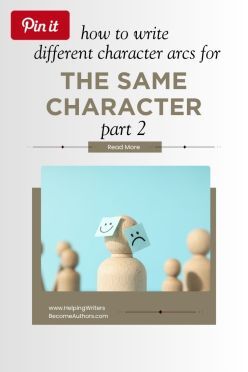 One of the most exciting challenges in storytelling is writing characters who grow over time—not just within a single story, but across several. Whether you’re working on a series or revisiting a familiar protagonist in a new standalone, the question inevitably arises: How do you create different character arcs for the same character without repeating yourself? How do you honor what’s come before while still offering readers something new? In many ways, this is where character development becomes the most rewarding—when you’re not just building a compelling arc, but an evolving journey.
One of the most exciting challenges in storytelling is writing characters who grow over time—not just within a single story, but across several. Whether you’re working on a series or revisiting a familiar protagonist in a new standalone, the question inevitably arises: How do you create different character arcs for the same character without repeating yourself? How do you honor what’s come before while still offering readers something new? In many ways, this is where character development becomes the most rewarding—when you’re not just building a compelling arc, but an evolving journey.
Last month, we did a bit of exploring about how to vary your character arcs by using the Enneagram system to identify different internal conflicts for characters with different personality types. We also talked about how pairing Enneagram insights with the archetypal Life Cycle can generate arcs that are not only distinct but also deeply resonant. However, as I mentioned last week in the first installment in this two-part series, the more I sat with that discussion, the more I realized there was another layer we hadn’t fully uncovered: what happens when you’re writing different character arcs for the same character?
The reader question that originally inspired these discussions (about how to use the Enneagram’s nine types to avoid repetitive Lies the Character Believes) sparked a larger reflection, not just on personality theory, but on long-term character development. If you’re writing a series or revisiting a character across multiple stories, you’ve likely asked yourself: How do I keep this arc feeling fresh? What else can this character learn, face, or become? The challenge isn’t just variety for its own sake. Rather, it’s about honoring the integrity of your characters while continuing to push their evolution in meaningful ways.
Last week, I offered six progressive systems you can use to help you chart long-term serial character arcs. This week, I want to dig into some general principles for approaching a character’s journey as an unfolding process that stretches beyond a single arc.
In This Article:How to Write Different Character Arcs for the Same Character: Write Different ThemesUsing Robert McKee’s Thematic SquareExploring Different Archetypal Roles (Beyond the Life Cycle)Exploring Different Backstory GhostsHow to Deeply Develop a Single Theme: Listen to Your CharactersExploring Different Inner FacetsChanging Up the Supporting CastExploring Consequences From Previous BooksEmphasizing Different EmotionsHow to Write Different Character Arcs for the Same Character: Write Different ThemesLet’s start by exploring the two different approaches you might find yourself in when writing multiple books. The first is the possibility that you are writing totally different character arcs for each new story. This might be because you’re writing an entirely new cast of characters and don’t want to repeat yourself; or it could be because you’re writing an episodic series in which you want to explore new plots and arcs in each installment.
In either case, the simplest rule of thumb when wanting to write different character arcs for the same character is to focus on exploring different external aspects. Basically: write a different plot. A relatively good example of this is the MCU, which featured dozens of stories set in the same story world. The series often succeeded in creating varied character arcs by offering varied or unexpected plots.
>>Click here to read The Do’s and Don’ts of Storytelling According to Marvel
For Example:
Tony Stark’s themes of escapist irresponsibility created very different themes from Peter Parker’s mistakes of teenage naivety.

Spider-Man: Homecoming (2017), Sony Pictures, Marvel Studios.
Here are a few more tools you can use to help you accomplish this variation.
1. Robert McKee’s Thematic Square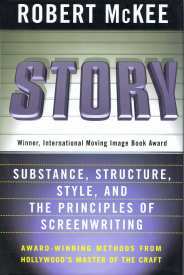
Story by Robert McKee (affiliate link)
Plot is tied to character arc which is tied to theme. The Thematic Square is a storytelling tool created by Robert McKee in his book Story that helps writers explore theme from multiple angles by identifying not only the central value (e.g., love) and its opposite (e.g., hate), but also a contrary value (e.g., indifference) and its negation (e.g., self-hatred). In a single story, this can help you create layered moral complexity and richer character conflict. However, by exploring a different quadrant of the square in different stories, you can visit various thematic neighborhoods within the same world from story to story.
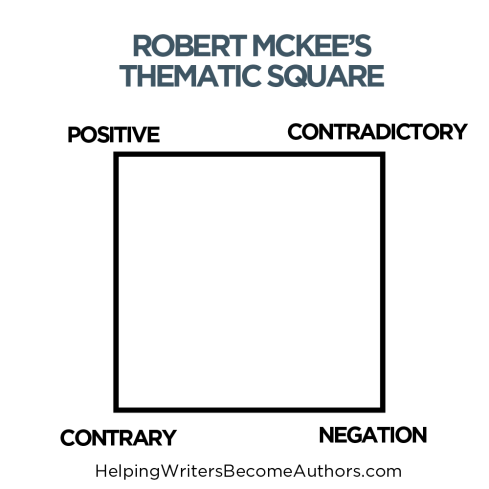
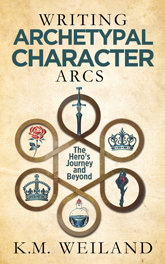
Writing Archetypal Character Arcs (affiliate link)
In addition to the continuity of the archetypal Life Cycle (which I mentioned last week and which you can read more about in my book Writing Archetypal Character Arcs), you can also focus on other ancillary archetypes. For example, exploring how your protagonist manifests the Trickster aspects of persoanlity in one story, the Rebel in another, and the Caregiver in still another can create opportunities for wildly different character arcs. Here’s a quick list of possibilities:
The Trickster – Brings chaos, humor, and unexpected change, often disrupting the status quo.The Ally – Supports others through trials as a loyal companion.The Shapeshifter – Changes form or allegiance, often creating doubt and intrigue.The Innocent – Seeks happiness and safety, often symbolizing purity or naiveté.The Orphan – Craves belonging and connection after experiencing loss or abandonment.The Rebel – Challenges norms and fights against injustice or oppression.The Sage – Pursues truth and knowledge, often as a detached observer.The Creator – Builds, innovates, or brings visions into reality.The Caregiver – Protects and nurtures others, often sacrificing personal needs.3. Explore Different Backstory GhostsFinally, as you seek to generate new and different character arcs throughout your series, remember that the catalyst for any character arc is the character’s backstory Ghost (sometimes called the wound). To explore different character arcs for the same character, look at different catalyzing events in your character’s past. This is a common (although often overdone) approach for TV series. When they finish one story arc and need to pursue a fresh angle, they will often reveal new and unexpected events in the characters’ pasts that link them to new conflicts.
For Example:
After wrapping up its initial storyline and associated character arcs in Season 5, Supernatural extended its run by introducing new backstory elements, notably the main characters’ reaction to secrets in their family’s past, including the fact that their mother had been a Hunter before meeting their father.
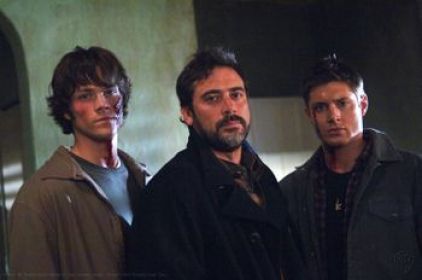
Supernatural (2005-2020), The CW.
How to Deeply Develop a Single Theme: Listen to Your CharactersWhat if you’re writing a series with an overarching plot that goes deep with a thematically cohesive character arc for your protagonist? In that case, how can you keep each story’s exploration of this overarching theme fresh and interesting, while also advancing the bigger arc?
The first thing to remember is that, in any story or series of stories, the thematic Truth a character learns (and therefore the successive Lies the Character Believes that must be overcome) exists along an ever-evolving spectrum. Therefore, even though the character may learn some version of an “ultimate” Truth by the story’s end, that Truth will be built of many smaller realizations and epiphanies along the way.
To progress that thematic throughline in a way that feels both realistic and also deep and nuanced, the most important trick is simply to listen to your characters. Really, this means listen to yourself. Listen to your own deep, innate knowing of how personal change occurs and what questions, roadblocks, sacrifices, and triumphs are likely to feel resonant along the way.
Here are a few tips and tricks for deepening your theme from book to book in a series.
1. Explore Different Inner FacetsIn any dramatic personal change (and therefore in any dramatic character arc) many different facets of the person will be affected. Depending on the length of your series, you have the opportunity to go deep with many different ways your characters are affected by the changes they are undergoing. For example, in one story you might explore how the change impacts the protagonist’s relationships, while in another you might explore how it impacts the protagonist’s experience of hope versus despair, while still another might delve into issues of ongoing personal integrity in the face of the changes the character is confronting.
2. Change Up the Supporting CastOne of the easiest ways to open new opportunities for exploring different facets of your characters is to change up the supporting cast. The thematic elements that arise from your protagonist’s interaction with a parent will be very different from the thematic elements that arise from your protagonist’s interaction with a love interest or frenemy. The only caution here is to make sure that in changing up the cast dynamics, you are not shortchanging the screentime of any key relationships that may, in fact, be the primary reason readers are there in the first place.
3. Explore Consequences From Previous BooksThe juiciest part of any series is its unparalleled ability to go deep with its own consequences. If you’re uncertain how your character’s arc might be different in a subsequent book, start by asking yourself:
What’s changed?What did the characters do or have done to them in the previous book that has consequences?How did the conclusion of the character arc in the previous book change how the character views the world or him/herself?Start pulling threads and exploring what new thematic avenues may now be open to you.
For Example:
The BBC show Poldark was particularly good at this from season to season. Its protagonist, Ross Poldark, rarely made a decision that didn’t have unforeseen but still realistic consequences. One example is his secret purchase of his cousin’s widow’s shares in his then-worthless mine, in order to gift her with needed money. When that mine later became profitable, he was accused by his nemesis of underhanded dealings in “stealing” from her.

Poldark (2015-2019), BBC One.
4. Emphasize Different EmotionsFinally, one of the easiest ways to tap into new and different character arcs for the same character is to explore different emotions. If anger predominated in one book, then perhaps joy or love may be the focus of another. If confidence and self-realization showed up in one book, then despair or disillusionment may follow. Particularly, think about how the “positive” or “negative” charge of one emotional theme can arc into its opposite. For example, in a long series, a defeat may follow a victory may follow a defeat.
Obviously, no one book should focus exclusively on a single emotion. But you can go deep with one emotion as a way of shining its particular shade of color onto the larger stage of your story’s and series’ themes.
***
Exploring different character arcs for the same character invites writers into some of the richest possibilities storytelling has to offer. It asks you to think deeply about the long-term consequences of change, how different parts of a character’s psyche can take center stage at different times, and how transformation itself evolves. Whether you’re crafting a series, revisiting an old character, or simply playing with the idea of continuity across your stories, this kind of narrative layering can open up new creative depths for both you and your readers.
In SummaryWriting different arcs for the same character requires more than just inventing new external conflicts. It demands an understanding of how transformation can unfold in complex, realistic, and meaningful ways across time. By focusing on how plot, character, and theme create and influence one another, you can gain deeper insights into how to naturally and resonantly evolve your character through multiple different character arcs.
Key TakeawaysDifferent arcs for the same character are best built around new thematic focuses and inner conflicts, as well as new plots.Tools like the Thematic Square and archetypal roles (such as Trickster and Caregiver) can offer helpful variety and depth in mapping believable inner change.Long-term character growth feels most authentic when arcs build on each other through a deep understanding of personal transformation and thematic intent.Revisiting a character can offer opportunities to explore consequences from past books, new emotional outlooks, and different relationship dynamics.Want More?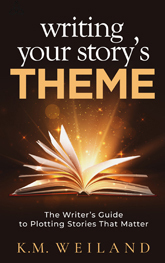
Writing Your Story’s Theme (Amazon affiliate link)
If you’re fascinated by the deeper structure behind character arcs—and especially how they connect to theme—check out my book Writing Your Story’s Theme. In it, I explore how character change is naturally intertwined with plot and theme. These “big three” naturally work together to create cohesive and resonant stories. Whether you’re writing standalone stories or weaving a multi-arc journey across a series, your characters’ emotional evolution is most impactful when it’s inextricably tied to the thematic heart of your story. Writing Your Story’s Theme offers a step-by-step approach to identifying, developing, and integrating theme at every stage of your story’s structure and your characters’ growth. It’s the perfect companion for writers who want their stories to resonate on every level. It’s available in paperback, e-book, and audiobook.
Wordplayers, tell me your opinions! Have you ever written different character arcs for the same character across multiple stories? What challenges or discoveries did you encounter in keeping those arcs fresh and meaningful? Tell me in the comments!Click the “Play” button to Listen to Audio Version (or subscribe to the Helping Writers Become Authors podcast in Apple Podcast, Amazon Music, or Spotify).
___
Love Helping Writers Become Authors? You can now become a patron. (Huge thanks to those of you who are already part of my Patreon family!)The post How to Write Different Character Arcs for the Same Character (Part 2 of 2) appeared first on Helping Writers Become Authors.
June 9, 2025
How to Write Different Character Arcs for the Same Character (Part 1 of 2)
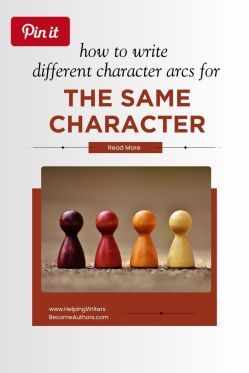 One of the most interesting challenges of writing a series is figuring out how to create different character arcs for the same character, without it feeling repetitive or forced. Whether you’re writing a progressive arc that unfolds over several books or you’re exploring entirely different arcs in each installment, the goal is always to keep the character’s journey fresh and meaningful.
One of the most interesting challenges of writing a series is figuring out how to create different character arcs for the same character, without it feeling repetitive or forced. Whether you’re writing a progressive arc that unfolds over several books or you’re exploring entirely different arcs in each installment, the goal is always to keep the character’s journey fresh and meaningful.
Last month I shared a post about developing different character arcs using the Enneagram personality system. However, after writing that post (and its follow-up about how to unite the Enneagram with the archetypal Life Cycle for even deeper character arcs), I realized I hadn’t quite got to the heart of the question that inspired that original post, from Zoe Dawson:
What is your take on using the Enneagram nine personality types and constructing their Lies so that it’s not repetitious for each story?
Although Zoe’s question was specifically about the Enneagram, the deeper underlying dilemma is one any author writing more than one story will eventually face: How can you make sure you’re writing varied and interesting character arcs—rather than just repeating yourself?
This quandary may ring true in a number of different scenarios:
You’re writing a series in which each book features progressive character arcs that all tie into a larger overarching arc.You’re writing a series that features a thematically new and independent character arc for each story.You’re writing multiple unrelated books and want each one to be fresh and different.
Writing Your Story’s Theme (Amazon affiliate link)
Today, I want to dig deeper into the big picture of how to construct Lies the Character Believes, character arcs, and themes that don’t repeat from story to story. This week, we’ll dig into some specific tools and frameworks that can help you shape varied arcs; next week, we’ll explore some general principles to keep in mind.
To get us started, here’s an idea I’ve always found resonant and that can be helpful to keep inmind when seeking to vary your writing:
We all have one story to tell and we just go on telling it in different ways.
Now, is that explicitly true?
Certainly not.
I, for one, have written one novel after another that is completely different from one another. And yet, I do feel that every story in an author’s body of work must ultimately point to the deeper truths and themes of the foundational story that is the author’s own life. No matter how much you may (or may not) change the outer trappings in your story (genre, setting, plot focus, etc.), the underlying thrust and focus will always be you.
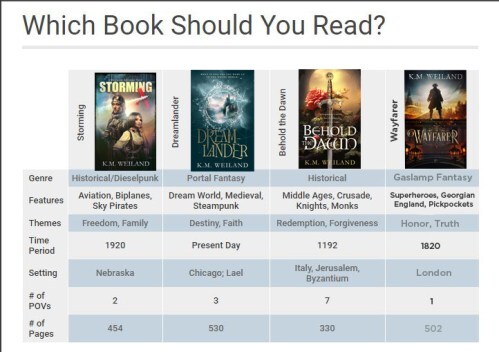
Click to enlarge.
I don’t see this as a drawback. I see it as the most compelling offering every author brings to their readers. In fact, I would suggest you might be most successful in varying your character arcs across books once you can realize the thrust of your own underlying interest and intention. For example, no author was perhaps more famous for writing a legion of staggeringly quirky and unique characters than Charles Dickens, yet even a cursory familiarity with his stories shows the underlying cohesion of the author’s focus on social issues, particularly the plight of the city’s poor. As you brainstorm new and different character arcs for your stories, it might be worthwhile to start by first identifying what actually makes them the same.
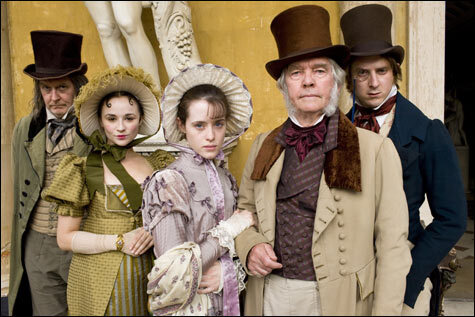
Little Dorrit (2008), BBC / WGBH Boston.
In This Article:6 Progressive Personalities and Development Systems to Write Different Character ArcsThe Five Foundational Character ArcsThe Life Cycle of Archetypal Character ArcsEnneagram Map of HealthSpiral DynamicsThe Four Stages of AlchemyThe Four Stages of Knowing6 Progressive Personality and Development Systems to Write Different Character Arcs for the Same CharacterLet’s start where this question is trickiest: How to write different character arcs for the same character?
One powerful way to write different character arcs for the same character is to ground the character’s growth in a larger developmental framework. Just like real people, characters evolve through recognizable stages—emotionally, psychologically, and even spiritually. Mapping your characters’ journeys to a progressive system can offer a shortcut for creating arcs that feel both fresh and cohesive across a series.
The following models can offer useful blueprints for tracking your characters’ inner evolution and continuing to shift the lens through which they experience the world.
1. The Five Foundational Character Arcs
Creating Character Arcs (Amazon affiliate link)
The basic “shape” of foundational character arcs can, in themselves, guide you to resonant variations. These foundational arcs (which I talk about in-depth in my book Creating Character Arcs and elsewhere) are:
Heroic ArcsPositive Change ArcFlat Arc>>Click here to read more about the Heroic Arcs.
Negative Change ArcsDisillusionmentFallCorruption>>Click here to read more about the Negative Arcs.
You can mix and match these arcs from story to story to create vastly varied experiences. The simplest approach is to observe the natural connections among them, especially between the two Heroic Arcs and the three Negative Change Arcs, respectively.
The Positive Change Arc—in which the character overcomes a limited Lie-based perspective and gains a broader Truth-based perspective—leads naturally into a subsequent Flat Arc—in which the character can stand upon this newly gained Truth to inspire change in others.
Likewise, the Negative Arcs can be crafted as part of a larger cycle. The character might undergo a Disillusionment Arc—in which a difficult new Truth creates a vulnerability that may lead to resistance or resentment. This can then easily lead into a Fall Arc, in which the character bolsters resistance to the Truth by investing in greater and greater Lies. This easily leads into the still worse Corruption Arc, in which a character who once had the opportunity and advantage of recognizing the Truth instead opts to reject it utterly.
2. The Life Cycle of Archetypal Character Arcs
Writing Archetypal Character Arcs (affiliate link)
In my book Writing Archetypal Character Arcs, I fleshed out the mythic lens of storytelling beyond just the Hero’s Journey to explore the full gamut of the human Life Cycle. Each of these six foundational archetypal character arcs naturally leads one into the other, making them perfect for a series in which you wish to explore an ever-maturing character.
These six foundational archetypes are:
The Maiden (Individuation)The Hero (Service)The Queen (Leadership)The King (Sacrifice)The Crone (Surrender)The Mage (Transcendence)You can find even more possibilities for variation—while adhering to a solid thematic throughline—by also exploring the six Flat archetypes and the twelve shadow archetypes that accompany each of the primary archetypes.

Graphic by Joanna Marie Art.
3. Enneagram Map of Health
Personality Types by Don Richard Riso and Russ Hudson (affiliate link)
Last month, I offered quite a few new tools and perspectives for using the Enneagram personality system to develop your character arcs. One particularly useful aspect I did not touch on was the stages of growth inherent to each type. In their book Personality Types, Don Richard Riso and Russ Hudson map nine stages for each type, ranging from healthy to average to unhealthy. Each of these stages could be fleshed out into a full character arc with the stages advanced in either direction, depending on whether you wanted to ultimately tell a story of a character who changes positively or negatively.
For example, the nine stages of Type Eight (the Challenger) are listed like this (from healthy to unhealthy):
The Magnanimous HeartThe Self-Confident PersonThe Constructive LeaderThe Enterprising AdventurerThe Dominating Power BrokerThe Confrontational AdversaryThe Ruthless OutlawThe Omnipotent MegalomaniacThe Violent Destroyer4. Spiral Dynamics
Spiral Dynamics by Don Edward Beck and Christopher C. Cowan (affiliate link)
Created by Don Beck and Chris Cowan, Spiral Dynamics is a model of human development that maps how individuals and societies evolve through increasingly complex value systems. Each stage—represented by a color—reflects a particular worldview, from basic survival to tribal loyalty to achievement and beyond. In character development, Spiral Dynamics can help you explore how a character’s core motivations and beliefs shift over time. As they move up (or regress down) the spiral, they may adopt new values, question old assumptions, or clash with characters operating from different stages, all of which can offer rich material for varied arcs across a series.
The currently recognized stages or “memes” of the spiral are:
Beige (SurvivalSense): Basic survival priorities (e.g., food, water, shelter, safety).Purple (KinSpirits): Tribal loyalty, superstition, tradition.Red (PowerGods): Dominance, ego, power, and asserting control over others (also called the Warlord meme).Blue (TruthForce): Order, rules, morality, and obedience to a higher purpose or authority.Orange (StriveDrive): Achievement, success, science, and rational progress.Green (HumanBond): Equality, empathy, community, and consensus-driven values.Yellow (FlexFlow): Integration, systems thinking, flexibility, and personal responsibility.Turquoise (GlobalView): Holistic awareness, unity, and spiritual consciousness.5. The Four Stages of AlchemyOriginally developed in the Middle Ages as a supposed process of turning lead into gold, the stages of alchemy are now recognized as a symbolic representation of … you guessed it, character arcs! (Aka, psychological development. Potato. Potahto.) A few years ago, I shared a post showing how the four stages of alchemy map perfectly onto the four quarters of story structure and, therefore, character arc. However, you can also choose to represent each stage as an entire arc of its own, allowing a four-story cycle to reveal the final alchemy. For that matter, many explorations of alchemy posit many more stages than just four, which could allow you to both lengthen and deepen your story arc.
The four basic stages of alchemy are:
The Nigredo (The Blackening): Descent into darkness, confusion, breakdown, ego death.The Albedo (The Whitening): Purification and clarity, recognizing truth, separating from illusion.The Citrinitas (The Yellowing): Insight, illumination, integration, growing wisdom.The Rubedo (The Reddening): Wholeness, rebirth, final transformation into the true self.6. Four Stages of KnowingEarlier this year, I similarly explored how the popular “four stages of knowing” also map neatly onto the four quadrants of a story’s development. Just as with the alchemical process, you can also stretch these stages to explore each aspect of the transformation more deeply in multiple evolving character arcs.
The Four Stages of Knowing are:
Not Knowing That You Don’t Know: Unconscious ignorance.Knowing That You Don’t Know: Conscious ignorance.Not Knowing That You Know: Unconscious competence.Knowing That You Know: Conscious competence.***
All of these frameworks—whether psychological, mythic, philosophical, or symbolic—can offer powerful scaffolding for exploring different character arcs for the same character without losing cohesion or authenticity. Not only can they help you avoid repetition, they can also support you in uncovering the deeper throughline of meaning that connects your stories to each other—and to you!
Next week, we’ll zoom out for a big-picture look at some guiding principles and narrative strategies you can use to vary your character arcs across multiple books or series. We’ll explore how to make your arcs feel intentional and fresh without straying too far from the heart of what makes your storytelling uniquely yours. Stay tuned!
In SummaryWhen writing multiple stories—whether within a series or across a body of work—one of the most powerful ways to ensure fresh and meaningful character arcs is to root them in the natural evolution of human development. By drawing on progressive models like the five foundational arcs, archetypal Life Cycle, Enneagram growth stages, Spiral Dynamics, and other systems, you can create nuanced journeys that build upon one another rather than repeat. Recognizing your own thematic throughline as an author only deepens the authenticity of these arcs. Next week, we’ll look at broader storytelling principles that can help you vary arcs across books, even outside of progressive systems.
Key TakeawaysRepetition in character arcs is a common challenge for writers of series or multiple books, but it can be overcome with intention and structure.
Developmental models like the five foundational character arcs or the archetypal Life Cycle can offer a roadmap for evolving your character’s journey meaningfully across books.
The Enneagram and Spiral Dynamics can offer deep personality and value-system frameworks that naturally lend themselves to transformation over time.
Alchemy and symbolic systems can add depth and metaphorical resonance to character progression.
Discovering your own thematic signature as an author can be a compass for creating unique yet unified arcs across your body of work.
Want More?
Writing Archetypal Character Arcs (affiliate link)
If you’re looking to deepen your understanding of character development and ensure your cast evolves in meaningful, thematically resonant ways, my book Writing Archetypal Character Arcs offers a powerful framework. It explores six foundational arcs—Maiden, Hero, Queen, King, Crone, and Mage—that reflect universal patterns of growth and transformation. Whether you’re crafting a protagonist’s journey or exploring contrasting arcs for supporting characters, this resource can help you weave rich, symbolic layers into your storytelling. It’s perfect for anyone wanting to write dynamic character arcs for different characters across a standalone novel or an entire series. It’s available in paperback, e-book, and audiobook.
Wordplayers, tell me your opinions! How do you approach writing different character arcs for the same character in a series or across multiple books? Tell me in the comments!Click the “Play” button to Listen to Audio Version (or subscribe to the Helping Writers Become Authors podcast in Apple Podcast, Amazon Music, or Spotify).
___
Love Helping Writers Become Authors? You can now become a patron. (Huge thanks to those of you who are already part of my Patreon family!)The post How to Write Different Character Arcs for the Same Character (Part 1 of 2) appeared first on Helping Writers Become Authors.
June 2, 2025
The Danger of Overexplaining in Dialogue—and How to Avoid It
 Note From KMW: This week’s post is a quick one—but it covers a sneaky little habit that can creep into even the best of stories: overexplaining in dialogue. I’ve seen it in books I’ve read, and I’ve definitely caught myself doing it too. It’s easy to do when we want to make sure readers really understand what’s going on, but often, this dialogue mistake just ends up slowing the story and undercutting our characters.
Note From KMW: This week’s post is a quick one—but it covers a sneaky little habit that can creep into even the best of stories: overexplaining in dialogue. I’ve seen it in books I’ve read, and I’ve definitely caught myself doing it too. It’s easy to do when we want to make sure readers really understand what’s going on, but often, this dialogue mistake just ends up slowing the story and undercutting our characters.
If you’ve ever wondered whether you’re trusting your readers enough, this one’s for you! The post was inspired by an example so bad I’m paraphrasing rather than directly quoting it. :p I’ll be back next week with a longer post (and podcast), the first in a two-part series I’m really excited about. Stay tuned!
***
As writers, we work hard to earn our readers’ trust. Nothing shatters that trust faster than treating them like they’re not smart enough to keep up. One of the most subtle and common ways authors do this is by overexplaining in dialogue. This usually doesn’t happen intentionally, but out of the fear readers won’t “get it” unless you spell it out. Unfortunately, when you overexplain or repeat yourself, especially in dialogue, readers can feel like the story is talking down to them or even, simply, below their level. That’s a fast track to losing their interest.
Consider a fantasy novel I once read. The author wrote some good dialogue that effectively explained situations while also conveying attitude, nuance, and subtext. Unfortunately, she submarined the dialogue’s inherent buoyancy by having the narrating character explain everything that was said, almost to the point of paraphrasing the dialogue.
For example, in one particular scene, the narrator worried another character might react violently if awoken. This was made clear in the narrative, then repeated, almost word for word, in an immediately subsequent dialogue exchange. The story was otherwise a smart, funny romp. But the author’s penchant for explanation added deadweight that slowed the book down and made me, as a reader, want to start skimming.
Here’s a paraphrased example of how dialogue that repeats the narrative (and vice versa) can feel condescending to readers:
Marcella hesitated outside the bedroom door, clutching Marcus’s supper with both hands. Her fingers tightened around the clay bowl. The last time she’d tried to wake Marcus when he was having one of his episodes, he’d come up swinging—half-conscious and convinced she was someone else. She’d ended up with a sprained wrist and a bruised cheek.
She looked at Angelina. “I don’t think I should go in there,” she whispered. “Last time he had one of these nightmares, he thought I was someone else and attacked me. I hurt my wrist pretty badly.”
This version needlessly repeats the same information in both the narrative and the dialogue. The reader is told twice about Marcus’s violent outburst and the character’s fear—without any additional depth or emotional layering. It slows the pace and makes Marcella sound like she’s explaining the situation not to another character, but to the readers—as if the author doesn’t trust them to retain or interpret what they just read.
The best fiction respects the intelligence of its readers. When your narrative and your dialogue work together, rather than redundantly repeating each other, you create a more immersive, efficient, and respectful reading experience. Before you hit publish, take a pass through your dialogue scenes and ask yourself: “Am I letting the story speak for itself, or am I explaining things that are already clear?”
Trust your readers. They’re smarter than you think—and they’ll thank you for believing it!
Wordplayers, tell me your opinions! Have you ever caught yourself overexplaining in dialogue—or spotted it in a book you were reading? Tell me in the comments!The post The Danger of Overexplaining in Dialogue—and How to Avoid It appeared first on Helping Writers Become Authors.
May 26, 2025
Crafting Archetypal Arcs With Enneagram Insights
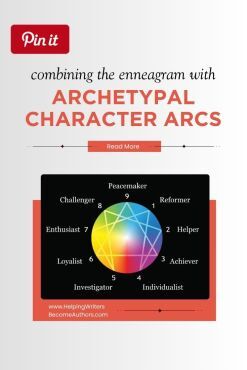 Note From KMW: Before we get started today, this is just a quick note to let you know that today is the final day you can save 25% off my entire store during my Memorial Day weekend sale. This includes all the e-books, workbooks, courses, and brainstorming guides. If you need some new writing tools, now’s a great time!
Note From KMW: Before we get started today, this is just a quick note to let you know that today is the final day you can save 25% off my entire store during my Memorial Day weekend sale. This includes all the e-books, workbooks, courses, and brainstorming guides. If you need some new writing tools, now’s a great time!
***
The Enneagram is often thought of as a personality system, but at its heart, it is an archetypal map of human motivation and transformation. Each of its nine types represents a universal pattern of behavior rooted in deep emotional truths (what we, as storytellers, might think of as thematic Truths). Like the Life Cycle of archetypes I explore in my book Writing Archetypal Character Arcs, the Enneagram reflects the evolving inner journeys we all undertake throughout our lives.
Although this archetypal similarity makes the Enneagram and the six Life-Cycle archetypes intuitive partners, it can also be difficult to sort the complexity of the two systems in a way that is actually useful for developing characters. Last week, we explored some of the innumerable possibilities for character-arc variation available within each Enneagram type. This week, I’m answering another reader question—from Elisheva–that points to this central conundrum of combining the Enneagram with the archetypes of the Life Cycle:
I love archetypes and I love the Enneagram, but when I try to use both tools when writing a story I get confused about how they interact. Both of them have their own Lies and conflict dynamics. And yet, they both are true. As a person, we go through the archetypical life stages, but we also have our personality to contend with. So, essentially, we are juggling the Lies and conflicts that come with each stage while also juggling the Lies and conflicts from our innate natures. How does this work when writing a story, so as not to confuse ourselves and others and get tangled in a conglomeration of themes, Lies, and conflicts—but to have it come through cohesively?
The shortest answer is that you don’t need to understand or combine both systems in order to create dynamic and dimensional characters. Often, the simplest approach is best, in which case focusing on either an archetypal approach or an Enneagram approach might be best. However, if you enjoy the complexity of examining how different systems combine to reveal even deeper insights into human behavior, then this is your stop!
In This Article:What Happens When You Combine Archetypal Arcs With Enneagram Insights?Enneagram Lies for the 6 Archetypes of the Life CycleType 1: The ReformerType 2: The HelperType 3: The AchieverType 4: The IndiviudalistType 5: The InvestigatorType 6: The LoyalistType 7: The AdventurerType 8: The ChallengerType 9: The PeacemakerBest Fit Enneagram Types for Each ArchetypeWhat Happens When You Combine Archetypal Arcs With Enneagram Insights?As I’ve explored in other posts (linked below), the Enneagram is a system of nine archetypal personality types, each representing a different core motivation and strategy for navigating the world. It maps surface behaviors, as well as the deep emotional patterns that drive our actions, fears, and desires. Unlike many personality systems, the Enneagram charts a path of growth, showing how individuals can evolve toward their healthiest, most integrated selves—or fall into patterns of stress and fixation.
>>Click here to read 5 Ways to Use the Enneagram to Write Better Characters
>>Click here to read 9 Positive Character Arcs in the Enneagram
>>Click here to read 9 Negative Character Arcs in the Enneagram
>>Click here to read Enneagram Types for Writers: Types 1-4
>>Click here to read Enneagram Types for Writers: Types 5-9
>>Click here to read Avoiding Repetition for Lies Each Type Might Believe
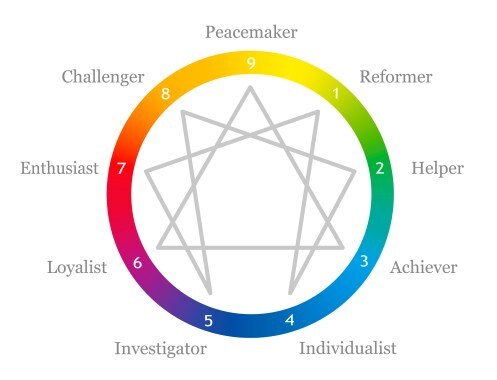

Writing Archetypal Character Arcs (affiliate link)
Similarly, the archetypal Life Cycle I explore in my book Writing Archetypal Character Arcs (and the Archetypal Character Guided Meditations) charts the universal phases of transformation we experience as we move through life. From the individuation of the Maiden, through the personal expansion of the Hero, the leadership of the Queen, the sacrifice of the King, the acceptance of the Crone, and the surrender of the Mage, the cycle demonstrates how archetypal energies evolve as we mature, confront challenges, and step into new roles within both our inner landscapes and our outer lives.
Combined, these two systems offer a richly layered view of human development. The Enneagram helps us understand the why behind our individual journeys (i.e., our motivations, blind spots, and inner work), while the archetypal Life Cycle provides a broader view of the when (i.e., the inevitable seasons of growth and change we all encounter). Together, they can create a powerful framework for writing deeper characters, as well as living more conscious, authentic lives.
Enneagram Lies for the 6 Archetypes of the Life CycleWhat follows is, as ever, a limited and subjective list of suggestions for how the themes of the Life Cycle and the Enneagram may mingle. My hope is that it will spark your own intuitive knowing about these deep archetypes, so you can find your own best interpretations for your characters and stories.
Type 1: The ReformerCore Lie: “I must be good to be worthy.”
Maiden’s Lie: “I must always be perfect to earn a place in the world.”
Book/Movie Example: Hermione Granger (Harry Potter) constantly seeks academic perfection to prove herself, but must individuate beyond the system of authority to learn which rules are worth breaking.

Harry Potter and the Philosopher’s Stone (2001), Warner Bros.
Hero: “I can only defeat evil if I never make mistakes.”
Theoretical Example: A police cadet learns that true bravery lies not in flawless actions, but in showing up and serving despite imperfections.
Queen: “Leading means upholding impossible moral standards.”
Book/Movie Example: Jean Valjean (Les Misérables) burdens himself with living a perfectly moral life after his redemption.
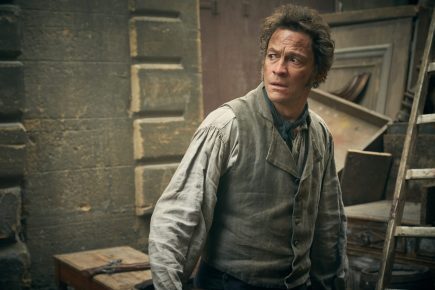
Les Miserables (2018-2019), BBC One.
King: “I must be flawless to maintain my authority.”
Theoretical Example: A legendary mob boss, feared and respected for his rigid moral code and flawless control, must face the devastating truth that his need to be untouchable is tearing his empire apart.
Crone: “I failed in life because I was never perfect enough.”
Book/Movie Example: Judge Danforth (The Crucible) struggles to evolve with the times, clinging to his rigid beliefs and refusing to acknowledge his mistakes.
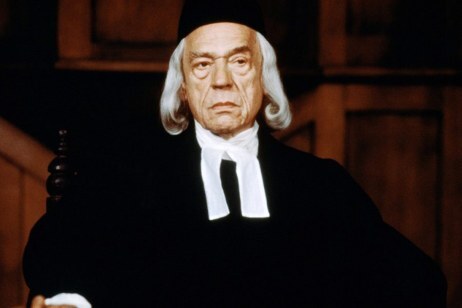
The Crucible (1996), 20th Century Fox.
Mage: “True wisdom is reserved for the flawless.”
Theoretical Example: A beloved professor, on the brink of retirement during a critical crisis facing his school, must confront his fear of leaving his students vulnerable and step back to let them take charge, trusting that their own mistakes will lead to the growth they need—while he comes to terms with the fact that his time as their guiding force has ended.
Core Lie: “I must earn love through service.”
Maiden: “If I am not useful, I will be abandoned.”
Theoretical Example: A young woman on the brink of adulthood believes she must constantly care for others and meet their emotional needs, even it means sacrificing her own dreams.
Hero: “I can only save others by sacrificing myself.”
Theoretical Example: A young paramedic, eager to prove his bravery and worth in service to his community, believes he must always be the first to respond to emergencies, even at the cost of his own well-being.
Queen: “I must care for everyone, even at the cost of my own needs.”
Movie Example: Mufasa (The Lion King) rules with compassion, but his inability to fully confront and neutralize the threat posed by his brother reveals his failure to assert the tough authority needed to protect the kingdom.

The Lion King (1994), Walt Disney Pictures.
King: “Real authority is earned by serving everyone else first.”
Theoretical Example: A veteran football coach, beloved for always putting his players first, must confront the painful truth that his need to be needed is holding the team back—and that the greatest act of service might be letting someone else lead.
Crone: “Without someone to care for, I have no purpose.”
Theoretical Example: A retired teacher, disheartened by the loss of her former vitality, is coaxed back into the community by a group of former students. She must reconcile with her own aging and accept that her contribution may now look different.
Mage: “Wisdom means knowing how to fix everyone’s pain.”
Theoretical Example: An aging master carpenter, watching his apprentices struggle with the pressures of their craft, must confront his deep need to fix their problems and allow them to endure the pain of their mistakes in order to grow into their own skill and wisdom.
Core Lie: “My worth depends on what I accomplish.”
Maiden: “I must earn the approval of my authority figures.”
Theoretical Example: A high school senior, eager to prove herself, constantly overextends her commitments and sacrifices her personal needs to earn the approval of her teachers and parents, believing her worth is defined by their recognition.
Hero: “I must win at all costs to prove my worth.”
Movie Example: Lightning McQueen (Cars) believes winning races is his only value.

Cars (2006), Walt Disney Pictures.
Queen: “My reign will only be respected if I am admired.”
Movie Example: Regina George (Mean Girls) seeks admiration above authentic leadership.

Mean Girls (2004), Paramount Pictures.
King: “My value lies in my success and productivity, so I must stay in control and maintain my position, even when it’s no longer serving the greater good.”
Play Example: Shakespeare’sRichard II clings to his throne, seeking personal validation and glory, but is ultimately forced to sacrifice his throne for the greater good of the kingdom when he realizes his inability to lead effectively has caused more harm than good.

The Hollow Crown (2012-2016), BBC Two
Crone: “Without accomplishments, I am nothing.”
Book/Movie Example: Miranda Priestly (The Devil Wears Prada) clings to her influence and refuses to advance her loyal employees.

The Devil Wears Prada (2006), 20th Century Fox
Mage: “I must prove my worth by making sure others succeed according to my standards, or I will be seen as ineffective or irrelevant.”
Theoretical Example: After decades of groundbreaking work, a renowned scientist hesitates to retire, fearing that stepping back will make his life’s achievements seem less significant if the next generation surpasses him.
Core Lie: “I must be unique to be significant.”
Maiden: “I must be unique and different to be truly valued, and if I don’t stand out, I’ll never be understood.”
Theoretical Example: A sheltered artist, struggling to believe her voice matters in a noisy world, is unsure how to break free from the expectations placed on her by family and society.
Hero: “I must prove my worth through my struggles and pain, or I will never truly be seen as special or important.”
Theoretical Example: A struggling musician determined to make it big must learn that personal growth comes not just through artistic expression, but by accepting himself and others.
Theoretical Example: A compassionate community organizer fears that if she imposes responsibility on others, she will be misunderstood and rejected for being too rigid or impersonal.
King: “My uniqueness sets me apart from everyone, including those I lead.”
Theoretical Example: An aging founder of a successful nonprofit, believing his uniqueness is what made the organization thrive, fears his departure will cause the loss of his individuality and the purpose he’s created.
Crone: “I was always too different to truly matter.”
Book/Movie Example: Miss Havisham (Great Expectations) isolates herself after heartbreak.

Great Expectations (2012), Lionsgate.
Mage: “My wisdom is irreplaceable, and no one else can truly understand my unique insights.”
Theoretical Example: A once-celebrated maestro watches his protégés follow their own unconventional paths, overcoming his fear that if he doesn’t guide every decision, his unique vision and legacy will be forgotten.
Core Lie: “I have to protect my energy and stay self-sufficient.”
Maiden: “I must have all the answers and fully understand everything before I can be valued or take action.”
Theoretical Example: A refugee teenager feels she must handle every challenge on her own, fearing that asking for help would put her at the mercy of unfeeling authorities.
Hero: “I can’t act until I know everything.”
Theoretical Example: A young environmental activist believes that to make a real difference, he must single-handedly lead every initiative and never show vulnerability, fearing that depending on others will expose his lack of knowledge or authority.
Queen: “Leading requires complete control over information.”
Theoretical Example: A respected scholar must come to terms with the limitations of her intellect and find a balance between reason and the emotional needs of others, ultimately discovering that leadership requires vulnerability.
King: “I must hold onto control at all costs because if I let go, everything will fall apart and no one will be able to manage without me.”
Theoretical Example: A long-serving mayor of a small town struggles to step down, convinced that without his detailed knowledge of the community’s history and past decisions, the town’s future will unravel.
Crone: “My worth ended when I stopped learning new things.”
Book/Movie Example: Ben Weatherstaff (The Secret Garden) is initially withdrawn and resigned to his age and solitude, but must learn to open up and connect with the younger generation.

The Secret Garden (1993), Warner Bros.
Mage: “True mastery requires total detachment.”
Theoretical Example: An admiral who has led his fleet through countless battles must now nurture younger officers as they begin to oversee their own missions.
Core Lie: “Security must come from the outside.”
Maiden: “I can’t trust myself; someone else must guide me.”
Movie Example: Rapunzel (Tangled) clings to Mother Gothel’s authority even as she grows suspicious.
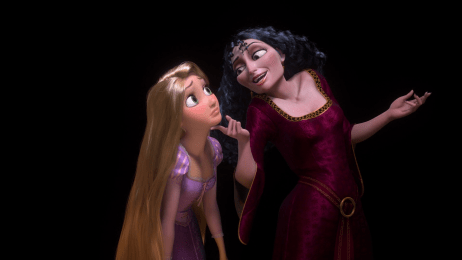
Tangled (2010), Walt Disney Pictures.
Hero: “I must rely on rules and authorities to survive.”
Theoretical Example: During the American Revolution, a young militia leader, determined to prove his worth in battle, hesitates to take command in the face of danger, fearing that if he fails, he will not only let down his comrades but prove he was never truly fit for leadership.
Queen: “The crown is safest when I control everyone’s loyalty.”
Theoretical Example: A new President, obsessed with maintaining unwavering loyalty from every member of her Cabinet, begins to micromanage their actions and decisions, believing any hint of dissent could unravel the entire country.
King: “I must eliminate all threats to maintain stability.”
Theoretical Example: A seasoned detective, revered for keeping his city safe through rigid oversight and paranoia, begins to unravel his own team with distrust and overreach, forcing him to realize that his need to control every threat is eroding the stability he built and that stepping aside is the only way to restore trust.
Crone: “I only mattered when others needed me for advice and support.”
Theoretical Example: An aging fairy godmother, long retired and forgotten, sinks into despair believing her worth ended when the kingdoms no longer needed her contribution—until a young, reckless princess unexpectedly seeks her out, forcing her to confront her fear of irrelevance and rediscover a deeper purpose in passing on her wisdom.
Mage: “True wisdom comes only from following tradition.”
Theoretical Example: An experienced blacksmith who has spent decades perfecting his craft allows his apprentice to explore modern advances.
Core Lie: “Pain must be avoided at all costs.”
Maiden: “I can’t commit to anything serious because if I do, I’ll be stuck and miss out on all the exciting possibilities life has to offer.”
Play/Book/Movie Example: To avoid sorrow and responsibility, Peter Pan (Peter Pan) refuses to grow up.

Peter Pan (2003), Universal Pictures.
Hero: “Winning means staying one step ahead of pain.”
Movie Example: Tony Stark (Iron Man) masks his trauma with wit and invention.

Iron Man 2 (2010), Marvel Studios.
Queen: “If I take on too much responsibility, I’ll lose my freedom and the joy of spontaneity that I crave.”
Show Example: Louis XIII (The Musketeers) refuses to face the mounting pressures of his reign, instead distracting himself with pleasures and escapism, believing that avoiding harsh realities will protect him from the pain of responsibility and prevent his kingdom from unraveling.
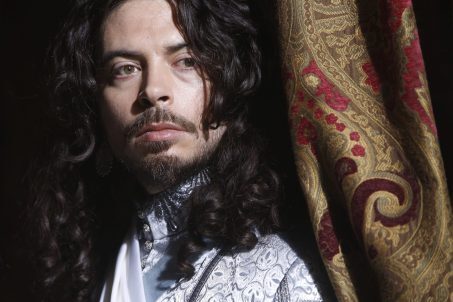
The Musketeers (2014-2016), BBC One
King: “If I step down, I’ll miss out on all the excitement and adventure, and my life will lose its purpose.”
Theoretical Example: The aging sheriff of a small frontier town refuses to retire, convinced that without the daily thrill of chasing outlaws and dispensing justice, his life will become empty and meaningless.
Crone: “If I stop chasing fun, I’ll face regret.”
Theoretical Example: In her twilight years, a once-vibrant grandmother convinces herself that if she keeps distracting herself with new hobbies and adventures, she can stave off the emptiness that comes with facing her mortality.
Mage: “I must keep my proteges entertained and excited with new ideas and challenges, or they’ll lose interest and never grow into their full potential.”
Book/Movie Example: Gandalf (The Lord of the Rings) sometimes feels the need to inject excitement and challenge to keep people engaged, especially during moments of stagnation.

The Lord of the Rings: The Fellowship of the Ring (2001), New Line Cinema.
Type 8: The ChallengerCore Lie: “Vulnerability equals weakness.”
Maiden: “If I don’t stay tough and in control, the world will crush me before I get the chance to grow up.”
Show Example: Haunted by the loss of her mother and consumed by shame over a secret mistake, a young Beth Dutton (Yellowstone) learns to weaponize her vulnerability—driving away Rip, the boy who loves her, believing that needing anyone will only lead to more pain and make her unfit to carry the Dutton legacy.

Yellowstone (2018-2024), Paramount Network.
Hero: “Victory demands total dominance.”
Book/Movie Example: Achilles (Troy) prioritizes glory over collaboration.

Troy (2004), Warner Bros.
Queen: “I must crush weakness to lead effectively.”
Movie Example: Princess Leia (Star Wars) believes that if she doesn’t keep absolute control over the Rebellion and shield everyone with her strength, everything she has built will fall apart.

Star Wars: A New Hope (1977), 20th Century Fox.
King: “Power must be protected at all costs.”
Theoretical Example: An ancient dragon-king refuses to name a successor, believing that if he releases his hold on the throne, chaos will consume the realm and erase everything he’s built.
Crone: “If I show any weakness now, the world will forget me.”
Theoretical Example: An aging private investigator, weary from years of solving crimes, struggles with the belief that if she doesn’t stay ahead of everyone, she’ll be left behind and forgotten.
Mage: “If I don’t control everything around me, everything will fall apart.”
Theoretical Example: A dying inventor must accept that without his direct involvement, the future of art and science will fall into the hands of the next generation—whether they are ready or not.
Core Lie: “My presence creates conflict.”
Maiden: “If I assert myself, I’ll anger those in authority.”
Movie Example: Cinderella (Cinderella) silently endures mistreatment to preserve fragile peace with her step-family.

Cinderella (2015), Walt Disney Pictures.
Hero: “Keeping the peace is more important than fighting for what’s right.”
Book/Movie Example: Frodo Baggins (The Lord of the Rings) hesitates to act against Gollum despite danger.

The Lord of the Rings: The Return of the King (2003), New Line Cinema.
Queen: “A ruler must maintain harmony at any personal cost.”
Theoretical Example: A single mother must reconcile with her teenage son’s drug use and her struggle to impose discipline.
King: “Leadership means erasing my own desires.”
Theoretical Example: An aging carnival owner, long seen as the heart of a beloved traveling show, must confront the truth that true harmony sometimes means letting go.
Crone: “My life mattered only when I avoided conflict.”
Theoretical Example: A retired diplomat refuses to enter the fray again even though she is needed.
Mage: “Wisdom is found only in silence and noninterference.”
Book/Movie Example: Professor Dumbledore (Harry Potter) initially withholds vital truths, believing noninterference safest.
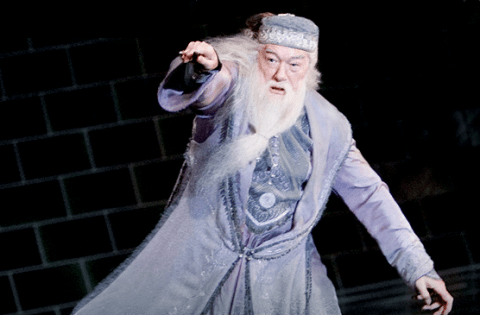
Harry Potter and the Order of the Phoenix (2007), Warner Bros.
Best Fit Enneagram Types for Each ArchetypeUnderstanding which Enneagram types align best with each character archetype can offer further insights for writers looking to craft psychologically resonant stories. Below, we’ll explore which Enneagram types can be the best fit for each of the six major archetypal arcs. As seen above, every Enneagram type will have the opportunity to embody each part of the archetypal Life Cycle. However, for the purposes of storytelling, certain Enneagram types more obviously align with the innate themes of certain life archetypes.
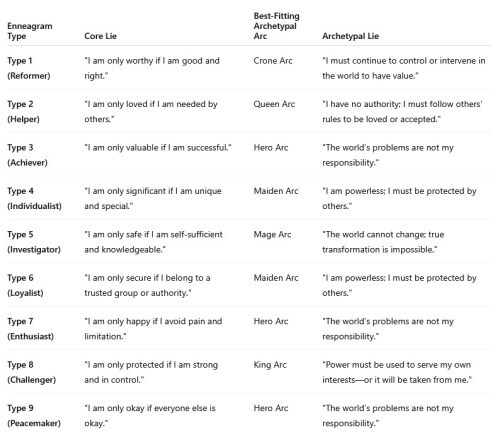
Click for a larger view.
1. Maiden ArcThe Maiden represents youth, innocence, and the early stages of growth. This archetype often involves a journey of self-discovery, in which the character confronts fears of inadequacy.
Suggested Best Fits:Type 2 (The Helper): Twos seek external validation and approval, often believing they must be useful to be loved or accepted. This aligns with the Maiden’s journey of proving her worth.
Type 4 (The Individualist): Fours often feel like outsiders and believe they’re too different or broken to belong. This aligns with the Maiden’s struggle to find her place.
Type 6 (The Loyalist): Sixes struggle with self-doubt and trust issues. This aligns with the Maiden’s early dependence on others.
2. Hero ArcThe Hero is the archetype of the individual who goes on a quest to prove himself, often facing trials that push him beyond his limits. This arc typically involves growth through challenges and the development of inner strength.
Suggested Best Fits:Type 3 (The Achiever): Threes are motivated by the desire to prove their worth through accomplishment. This aligns with the Hero’s need to confront the difference between authentic self-worth and success-driven identity.
Type 7 (The Enthusiast): Sevens seek excitement and avoid pain. This aligns with the Hero’s lessons in embracing hardships and responsibility, as well as the adventurousness found in many Hero stories.
Type 9 (The Peacemaker): Nines prefer to avoid conflict and maintain harmony. This aligns with the Hero’s lessons in standing up and taking action for what is right.
3. Queen ArcThe Queen archetype represents leadership, responsibility, and the balance of power with wisdom. The Queen must confront the tension between personal desires and the needs of others. She often faces internal conflict over whether to uphold idealistic values or to compromise for the greater good.
Suggested Best Fits:Type 1 (The Reformer): Ones seek perfection and uphold high moral standards. This aligns with the Queen’s responsibility to govern with justice.
Type 2 (The Helper): Twos may take on leadership roles out of a need to care for others. This aligns with the Queen’s struggle to balance the needs of the people she leads with the equal necessity for justice and fairness.
Type 3 (The Achiever): Threes are driven by a desire for success and admiration. This can align with the Queen’s desire to lead effectively while also ensuring she is loved and respected.
4. King ArcThe King is an archetype of mastery, authority, and moral leadership. Kings must balance power with compassion, making decisions that affect others, while also grappling with personal doubts about worth and legacy.
Suggested Best Fits:Type 1 (The Reformer): Ones value moral integrity while desiring to fix the world. This aligns with the King’s role as a ruler who holds the kingdom’s best interests at heart.
Type 6 (The Loyalist): Sixes seek stability and security, often taking on leadership roles when they believe they can protect others. This aligns with the King’s desire to shoulder the tremendous burden of total responsibility for his kingdom.
Type 8 (The Challenger): Eights possess a drive for control and strength; they must learn that real power comes from wisdom, not domination. This aligns with the King’s focus on authority and leadership.
5. Crone ArcThe Crone represents wisdom, reflection, and acceptance of life’s consequences. This archetype is concerned with legacy and the knowledge gained through life’s experiences.
Suggested Best FitsType 1 (The Reformer): Ones must learn to accept imperfection. This aligns with the Crone’s need to forgive herself and embrace her flaws.
Type 4 (The Individualist): Fours often feel like they are misunderstood or disconnected. This aligns with the Crone’s need to reflect on her life choices and embrace her true self.
 Type 5 (The Investigator): Fives search for knowledge and detachment. This aligns with the Crone’s focus on intellectual wisdom and the perspective gained over a lifetime. Fives can also align with the Hermit archetype, the negative aspect of which the Crone struggles with in her passive shadow form.
Type 5 (The Investigator): Fives search for knowledge and detachment. This aligns with the Crone’s focus on intellectual wisdom and the perspective gained over a lifetime. Fives can also align with the Hermit archetype, the negative aspect of which the Crone struggles with in her passive shadow form.
The Mage represents mastery, transformation, and the passing of knowledge. The Mage has the wisdom and skills to guide others, but may struggle with the isolation and surrender needed in the role of mentor.
Suggested Best Fits:Type 1 (The Reformer): Ones desire to fix and improve the world through wisdom and example. This aligns with the Mage’s role as a wise leader who desires to guide the young.
Type 3 (The Achiever): Mature Threes can provide guidance to others on how to achieve success while also needing to confront their need for external validation. This can align with the Mage’s role as a mentor who passes on knowledge.
Type 5 (The Investigator): Fives are natural learners and seekers of knowledge. This aligns with the Mage’s ability to impart wisdom to others.
Understanding the best-fit Enneagram types for each archetypal character arc can offer powerful insight into your characters’ internal journeys. When you align your characters’ Enneagram-driven fears and desires with the core themes of their archetypal arcs, you create a narrative with emotional resonance and psychological depth.
Whether your character is a Hero learning to face his limitations, a Queen learning to lead with integrity, or a Crone reckoning with her past, the Enneagram can add nuance and authenticity that helps bring the character arc to life. By thoughtfully pairing archetypes with Enneagram types, you can gain a dual lens through which to craft stories that both captivate and transform.
In Summary:Both the Enneagram and the archetypal Life Cycle systems are powerful tools for understanding human motivation and transformation. When combined, they can offer a deeper layer of insight into character development. The key challenge is balancing the complex dynamics of both systems without creating confusion in the story. While it’s not necessary to merge both systems to create dynamic characters, those who enjoy complexity can use them together to enrich their writing. Each Enneagram type brings its core Lie and conflict dynamics into the phases of the Life Cycle, influencing how characters evolve.
Key Takeaways:The Enneagram provides a framework for understanding a character’s motivations, fears, and desires, while the Life Cycle tracks universal phases of transformation.Combining both systems can deepen character exploration. However, it’s important to avoid overwhelming readers with too many conflicting themes and conflicts.Focusing on one system at a time (either Enneagram or archetypal Life Cycle) is a simpler approach, but integrating both can lead to more complex and nuanced character arcs.Using the core Lies and conflicts of each Enneagram type within the phases of the Life Cycle can help to create multidimensional characters that evolve through their internal and external struggles.Want More?If you’re ready to dive deeper into your characters and their journeys, my Archetypal Character Guided Meditations can help unlock fresh insights and inspire new creative possibilities. These guided meditations are perfect for dreamzoning, brainstorming, and exploring your characters’ core motivations from the inside out.
Whether your character’s story is best suited to the archetypes of Maiden, Hero, Queen, King, Crone, or Mage, these meditations will guide you to understand the heart of your characters and bring them to life in new and exciting ways. It’s like having a personal guide to help you dig into the soul of your story! Start exploring today: Archetypal Character Guided Meditations.
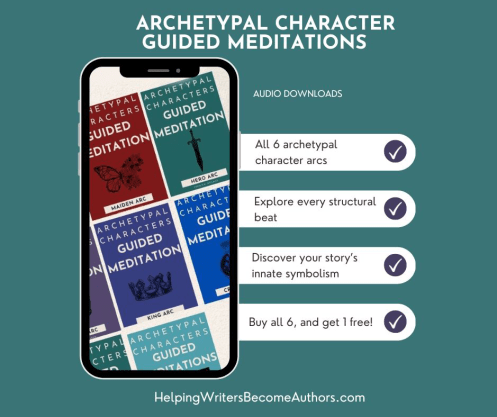
Go on the journey with your characters! Check out the Archetypal Character Guided Meditations.
Wordplayers, tell me your opinions! How do you merge archetypal characters with the Enneagram types in your writing? Which Enneagram type fits best with the archetypes you use, and how do their core motivations shape the journey? Tell me in the comments!Click the “Play” button to Listen to Audio Version (or subscribe to the Helping Writers Become Authors podcast in Apple Podcast, Amazon Music, or Spotify).
___
Love Helping Writers Become Authors? You can now become a patron. (Huge thanks to those of you who are already part of my Patreon family!)The post Crafting Archetypal Arcs With Enneagram Insights appeared first on Helping Writers Become Authors.
May 19, 2025
Using the Enneagram for Character Development: Avoiding Repetition for Lies Each Type Might Believe
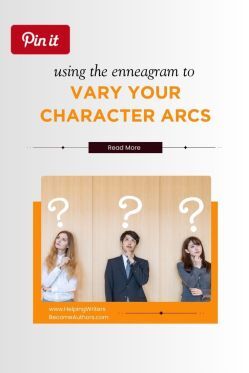 Using the Enneagram for character development can be a game-changer for crafting layered, believable characters. This ancient personality typing system can offer deep insight into your characters’ core fears and motivations, which makes it a natural fit for building compelling internal arcs. Because the Enneagram inherently emphasizes personal misconceptions (aka, the Lie the Character Believes), thematic Truths, and both Positive and Negative Change Arcs, it becomes an extremely intuitive tool for creating complex and realistic characters. But there is a rub.
Using the Enneagram for character development can be a game-changer for crafting layered, believable characters. This ancient personality typing system can offer deep insight into your characters’ core fears and motivations, which makes it a natural fit for building compelling internal arcs. Because the Enneagram inherently emphasizes personal misconceptions (aka, the Lie the Character Believes), thematic Truths, and both Positive and Negative Change Arcs, it becomes an extremely intuitive tool for creating complex and realistic characters. But there is a rub.
And the rub is that because the Enneagram features only nine personality types, it would also seem to offer only nine possible Lies, Truths, and character arcs. Zoe Dawson brought this up in requesting this post:
I use the Enneagram heavily in crafting my characters, so my question would be: What is your take on using the Enneagram nine personality types and constructing their Lies so that it’s not repetitious for each story? Examples would be great.
Although necessarily limited, the Enneagram still presents an incredibly comprehensive and complete framework for understanding human behavior. As such, there is a degree of truth to the idea that humans can only undergo a certain number of fundamental changes. This harks back to one of my favorite quotes, from Willa Cather:
There are only two or three human stories, and they go on repeating themselves as fiercely as if they never happened.
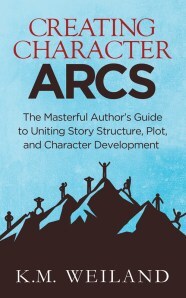
Creating Character Arcs (Amazon affiliate link)
Still, as Zoe points out, a prolific writer relying on the same framework for every character might find herself running into some repetition—especially when it comes to identifying the Lie each type believes. In previous posts, I’ve noted the fundamental Positive Change and Negative Change Arcs inherent within each core Enneagram type:
>>Click here to read 9 Positive Character Arcs in the Enneagram
>>Click here to read 9 Negative Character Arcs in the Enneagram
Today, I want to look at how to use the Enneagram to deepen your character work while keeping each journey distinct and emotionally resonant.
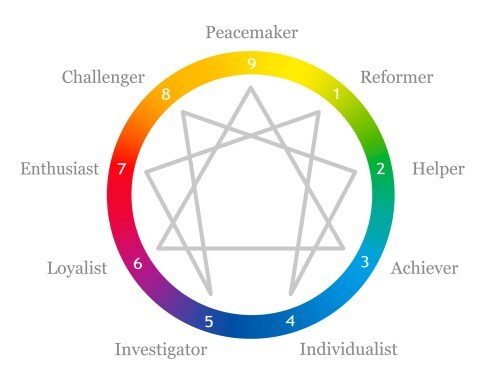
How can you avoid repetitive arcs when using personality tools like the Enneagram? If each type has a core fear and desire, doesn’t that mean every story featuring a Type One or a Type Nine will end up exploring the same emotional terrain?
Not at all.
In fact, using the Enneagram for character development can open up even deeper and more varied avenues for crafting emotional arcs. Although characters with the same type may struggle with the same core themes, the specific Lies they believe about themselves and the world can take many forms.
If you already know your own Enneagram type, you can think about this from the perspective of your own life. For example, as a core Three, I can easily look through my life and identify how my own core wounding, coping mechanisms, survival tactics, ego identities, and even interests and obsessions are predominantly themed around a Three’s central concerns with identity, authenticity, and personal truth. Indeed, even the fact that my explorations of story theory have focused on character arcs and the internal conflict between “Lies” and “Truths” is arguably a direct emergent from my Three perspective.
When most people think of Threes, they think of the stereotype: hyper-competent workaholic obsessed with success and image. If that’s all you knew about Threes, you might struggle to write characters with personalities nuanced enough to reveal the spiraling fractal of depth hidden behind this simplistic archetype. A deeper understanding of how the Enneagram works (not to mention how people and stories work) allows us to access the functional simplicity of this nine-part system as a foundation for the realistic variation it reveals.
From there, the Enneagram can become a wonderful tool for noticing and exploring the specific flavor of insight and blindness each type brings to any situation. In moving beyond the simplistic stereotypes to acknowledge the deeper themes at play for each type, the sheer vastness of thematic possibilities also becomes clear. For example, if you wanted to explore a Three’s obsession with the subjectivity/objectivity of Truth, you would discover what are likely unlimited character arcs that can eventuate. This is, of course, equally true of all the types.
Using Instinctual Variants to Create Unique Character Arcs
Writing Archetypal Character Arcs (affiliate link)
With all of that said, the suggestions I’m going to share in the rest of today’s post barely scratch the surface of the possible Lies any one type may be challenged to overcome. Next week, I’ll be digging into this a little deeper in answering another reader’s question with an exploration of how Enneagram types function in the different archetypes of the Life Cycle. For today, I decided the most useful way to begin examining the variety available within Enneagram character arcs would be to note how each type’s core Lie may vary depending on which instinctual variant is dominant.
What Are the Three Instinctual Variants?One of the most illuminating nuances in the Enneagram system is the concept of instinctual variants—what are sometimes called subtypes. These are the primal survival drives that shape how each of the nine types shows up in the world. Instinctual variants don’t change your core type, but they do flavor how that type expresses itself in everyday life.
For more on instinctual variants, I highly recommend Beatrice Chestnut’s book The Complete Enneagram.

There are three instinctual variants:
1. Self-Preservation (sp):This instinct centers around safety, comfort, and physical well-being. If this is your dominant instinct, you’re probably highly attuned to issues like health, finances, routine, and creating a secure personal environment. You might notice yourself scanning your life for what’s missing or unstable before anything goes wrong.
2. Social (so):This instinct is all about group dynamics, belonging, and impact. Social-dominant people pay close attention to how they fit into the collective. They’re often oriented toward their place in the tribe, their reputation, and their contribution toward something bigger than themselves. This doesn’t always mean extroversion; it’s more about their awareness of the system.
3. Sexual (sx):Also called the one-to-one instinct, this drive is focused on intensity, intimacy, and magnetism. It’s about fusion: being fully seen, fully known, and fully alive in the presence of another. People with a dominant sexual instinct crave depth in relationships and experiences. They often have a kind of “charge” to them—an edge, an allure, a sense of passion that leads the way.
CountertypesEven though each of us uses all three instincts, we tend to favor one, repress another, and let the third play a supporting role. (For example, because I am self-preservation dominant and social repressed, my instinct stack would be shown like this: sp-sx-so.)
Here’s the twist: the dominant instinct can sometimes override the “typical” behavior of your core type. This creates what are called countertypes—one specific orientation for each type that looks different from the core type, but which still lives out the same core fear and desire underneath. (For example, as you’ll see later on, the fact that I am a Three with a self-preservation dominant instinct makes me the countertype. In short: even though I always feel like a Three, I don’t always look like a Three.)
Understanding characters’ instinctual stacks can bring incredible clarity to what type of character arc and thematic journey they are most likely to undertake—and how that might evolve from story to story or even character to character, regardless of type.
Different Lies Each Enneagram Type Character Might BelieveLet’s look at how each Enneagram type can be used to explore a variety of Lies across different stories, genres, and voices. (Note that these examples should not be taken too explicitly—i.e., as the only way to express each subtype’s Lies. They are meant to spur your creativity, particularly in regard to the subjectivity of Enneagram types for the characters referenced. They are also not necessarily representative of a character arc that is completed in the referenced examples. As usual, I have relied on the typings from the site Funky MBTI.)
Type 1: The ReformerCore Lie: “I must be good to be worthy.”
Core Fear: Being corrupt, defective, or wrong.
Core Desire: To be good, virtuous, and balanced.
Social Lie: “If I don’t set the moral standard, no one will.”
Example: Hermione Granger (Harry Potter): Hermione’s obsession with studying, rules, and doing things “the right way” stems from her fear of failure and need to be seen as competent and morally upright.

Harry Potter and the Philosopher’s Stone (2001), Warner Bros.
Sexual Lie (COUNTERTYPE): “It’s up to me to set the world right—no matter the cost”
Example: Catherine Freneau (Father Goose): Catherine’s intensity stems from a deep sense of personal mission. She pushes herself and others toward transformation, often coming across as driven, zealous, and unrelenting in her pursuit of what she sees as necessary change—even when it strains her relationships.
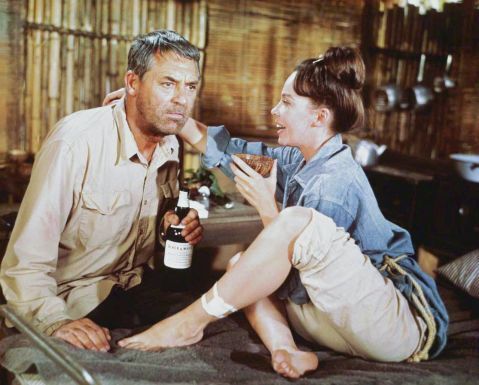
Father Goose (1964), Universal Pictures.
Self-Preservation Lie: “If I’m not prepared and perfect, I’ll be blamed.”
Example: Atticus Finch (To Kill a Mockingbird): With quiet resolve and unwavering principles, Atticus carries the burden of justice on his shoulders—believing that if he doesn’t stand strong, everything could unravel.

To Kill a Mockingbird (1962), Universal Pictures.
Type 2: The HelperCore Lie: “I must earn love through service.”
Core Fear: Being unworthy of love.
Core Desire: To be loved and needed.
Social Lie: “If I serve the greater good, I’ll be loved by all.”
Example: Padmé Amidala (Star Wars): Padmé sacrifices her personal desires to serve her people. She’s gracious and composed, always putting duty above self, but her deepest longing is to be accepted and loved for who she really is.

Star Wars: Attack of the Clones (2002), 20th Century Fox.
Sexual Lie: “If I am not needed by someone, I am not valuable.”
Example: Frances Stevens (To Catch a Thief): Frances is bold, alluring, and direct in her affections—flirting and pursuing while also deeply craving connection and validation beneath the surface.

To Catch a Thief (1955), Paramount Pictures.
Self-Preservation Lie (COUNTERTYPE): “If I act helpless or innocent, others will take care of me.”
Example: Robert Crawley (Downton Abbey): Robert often plays the helpless patriarch, relying on others to manage both personal and family matters while maintaining his sense of entitlement to care and attention.
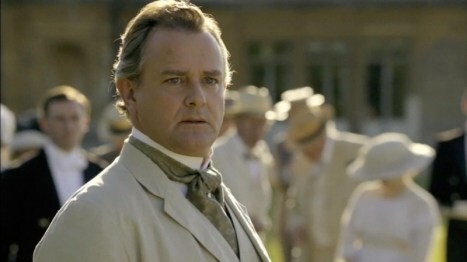
Downton Abbey (2010-15), ITV.
Type 3: The AchieverCore Lie: “My worth depends on what I accomplish.”
Core Fear: Being worthless or failing.
Core Desire: To be valued and admired for success.
Social Lie: “I must be admired and respected for my success.”
Example: P.T. Barnum (The Greatest Showman): Barnum thrives on his ability to garner admiration and respect through his business success and the spectacle he creates, positioning himself as a charismatic leader and influencer in the public eye.

The Greatest Showman (2017), 20th Century Fox.
Sexual Lie: “My value comes from how attractive and charismatic I am to others.”
Example: Scarlett O’Hara (Gone with the Wind): Scarlett builds her self-worth through her attractiveness and the way she charms others, seeing her relationships and romantic success as a reflection of her value.
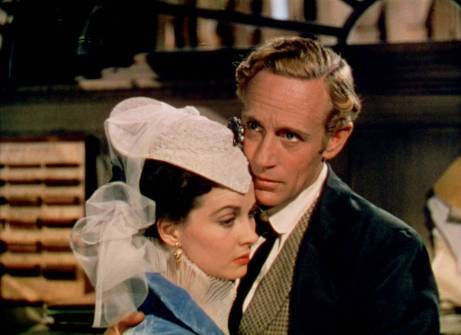
Gone With the Wind (1939), MGM.
Self-Preservation Lie (COUNTERTYPE): “I need to work hard and prove myself to secure my place.”
Example: Nancy Wheeler (Stranger Things): Nancy, driven by a need for accomplishment and approval, constantly works hard to prove her worth, even if it means compromising her personal needs for the sake of her career and goals.

Stranger Things (2016-), Netflix.
Type 4: The IndividualistCore Lie: “I must be unique to be significant.”
Core Fear: Being ordinary or not special.
Core Desire: To find themselves and their significance.
Social Lie: “My suffering makes me worthy of love.”
Example: Rose DeWitt Bukater (Titanic): Rose feels trapped and unseen, expressing her suffering as a way of asserting her individuality and longing for a more meaningful life.
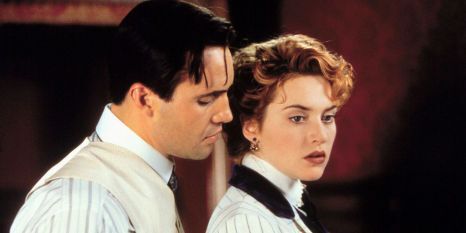
Titanic (1997), Paramount Pictures.
Sexual Lie: “If I fight hard enough for what I want, I’ll finally prove I’m not broken.”
Example: Kylo Ren (Star Wars: The Force Awakens): Kylo is consumed by his desire to prove himself, constantly fighting to overcome his perceived weakness and claim a powerful, meaningful identity.

Star Wars: The Force Awakens (2015), Lucasfilm Ltd.
Self-Preservation Lie (COUNTERTYPE): “If I keep pushing myself through pain, I’ll finally become who I’m meant to be.”
Example: Jess Mariano (Gilmore Girls): Jess hides his emotional sensitivity beneath a hardened exterior, relying on independence and quiet intensity to forge his own path in life.
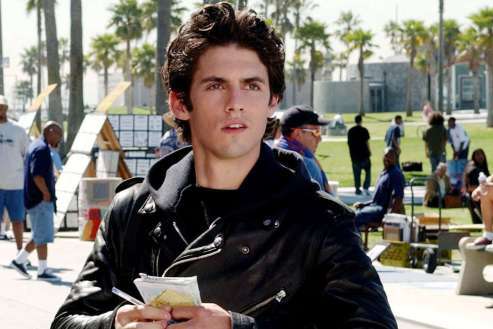
Gilmore Girls (2000-2007), The CW.
Type 5: The InvestigatorCore Lie: “I have to protect my energy and stay self-sufficient.”
Core Fear: Being overwhelmed or incapable.
Core Desire: To be competent and capable.
Social Lie: “If I master complex knowledge, I’ll earn my place in the world.”
Example: J. Robert Oppenheimer (Oppenheimer): Oppenheimer commands respect through genius, but remains emotionally withdrawn—even while standing at the center of a historical moment.
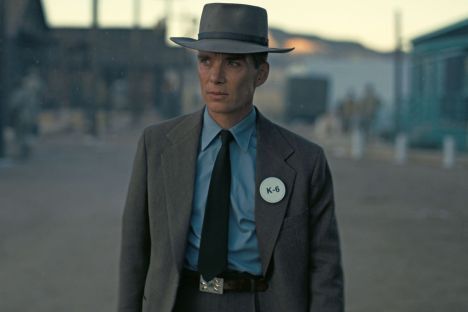
Oppenheimer (2023), Universal Pictures.
Sexual Lie (COUNTERTYPE): “If I fully merge with someone, I won’t feel so alone.”
Example: Scottie Ferguson (Vertigo): Scottie becomes obsessively attached to an imagined ideal of love, losing himself in his desire for a connection that will make him feel whole.
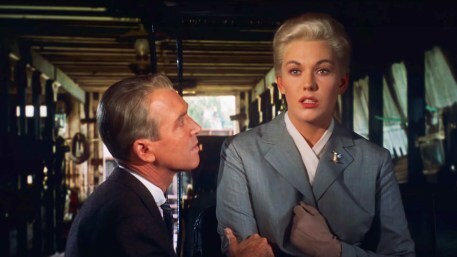
Vertigo (1958), Paramount Pictures.
Self-Preservation Lie: “If I hoard my resources and keep to myself, I’ll finally feel safe.”
Example: Ebenezer Scrooge (A Christmas Carol): Scrooge isolates himself and clings tightly to his wealth and solitude, believing this is the only way to feel secure in the world.

A Christmas Carol (2009), Walt Disney Pictures.
Type 6: The LoyalistCore Lie: “Security must come from the outside.”
Core Fear: Being without support or guidance.
Core Desire: To have security and guidance.
Social Lie: “If I follow the rules and uphold the system, I won’t have to be afraid.”
Example: Willow Rosenberg (Buffy the Vampire Slayer): Willow clings to structure—school, rules, the Scooby Gang—to soothe her insecurity, only stepping into independence when surrounded by trust and purpose.

Buffy the Vampire Slayer (1997-2001, The WB)
Sexual Lie (COUNTERTYPE): “If I’m strong and intimidating enough, nothing can hurt me.”
Example: Guy of Gisborne (Robin Hood): Guy compensates for his insecurity with aggression and dominance, trying to prove his worth through strength, loyalty, and desire.
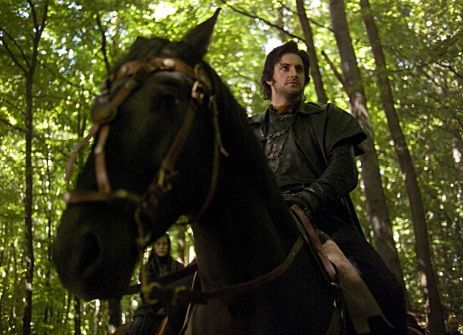
Robin Hood (2006-2009), BBC Studios.
Self-Preservation Lie: “If I stay close to what’s familiar and keep others happy, I’ll be safe.”
Example: Bilbo Baggins (The Hobbit): Bilbo prefers the safe predictability of his hobbit hole and resists adventure, until trust in others helps him find his courage.

The Hobbit: An Unexpected Journey (2012), Warner Bros.
Type 7: The EnthusiastCore Lie: “Pain must be avoided at all costs.”
Core Fear: Being deprived or trapped in pain or deprivation.
Core Desire: To experience satisfaction and fulfillment.
Social Lie (COUNTERTYPE): “If I serve a meaningful cause and stay upbeat, I’ll be valued and protected.”
Example: Elizabeth Bennet (Pride and Prejudice): Lizzy combines charm and cleverness with a sense of social justice and moral clarity, while using wit and idealism to sidestep vulnerability.

Pride & Prejudice (2005), Focus Features.
Sexual Lie: “If I follow my passions and chase the next dazzling experience, I’ll find what I’m missing.”
Example: Ariel (The Little Mermaid): Ariel dives headfirst into new worlds and romantic dreams, enchanted by what could be and driven by a restless hunger for something more.

The Little Mermaid (1989), Walt Disney
Self-Preservation Lie: “As long as I surround myself with the right people and pleasures, I’ll be fine.”
Example: Han Solo (Star Wars): Han seeks freedom, resources, and loyal allies to keep life pleasurable and self-serving, even while avoiding the emotional weight of deeper connection.

Star Wars: The Empire Strikes Back (1980), 20th Century Fox.
Type 8: The ChallengerCore Lie: “Vulnerability equals weakness.”
Core Fear: Being controlled or vulnerable.
Core Desire: To protect self and remain in control.
Social Lie (COUNERTYPE): “If I fight for others and protect what’s right, I can justify my strength and find belonging.”
Example: George Bailey (It’s a Wonderful Life): George is a passionate, justice-driven leader who sacrifices his own dreams to protect his community but still struggles with the weight of responsibility and frustration.

It’s a Wonderful Life (1947), Liberty Films.
Sexual Lie: “If I can overpower and possess what I want, I’ll never be betrayed or abandoned.”
Example: Erik Killmonger (Black Panther): Erik’s aggression stems from a deep fear that trusting anyone will lead to his downfall.

Black Panther (2018), Marvel Studios.
Self-Preservation Lie: “As long as I can take care of myself and get what I need, I don’t have to rely on anyone.”
Example: Henry VIII (The Tudors): Possessive and forceful, Henry demands absolute loyalty and control in love and power—unwilling to surrender anything once he’s claimed it.

The Tudors (2007-2010), BBC Two
Type 9: The PeacemakerCore Lie: “My presence creates conflict.”
Core Fear: Being overwhelmed by conflict and tension.
Core Desire: To create inner and outer peace.
Social Lie (COUNTERTYPE): “If I’m useful to the group, I’ll be safe and accepted.”
Example: Frodo Baggins (The Lord of the Rings): Frodo puts the fellowship’s mission above his own well-being, often losing himself in the needs of the collective.

The Lord of the Rings: The Fellowship of the Ring (2001), New Line Cinema.
Sexual Lie: “I only matter when I merge completely with someone else.”
Example: Bella Swan (Twilight): Bella dissolves her sense of identity into her relationship with Edward, struggling to separate her desires from his.

Twilight (2008), Summit Entertainment.
Self-Preservation Lie: “As long as I’m comfortable, nothing else really matters.”
Example: Queen Elizabeth II (The Crown): Elizabeth quietly clings to routine and the comforts of duty, avoiding emotional upheaval by keeping everything in its place.

The Crown (2016-2023), Netflix.
***
By integrating the Enneagram’s instinctual variants into your character development process, you gain access to a dynamic range of emotional and thematic possibilities, even within the same type. Far from boxing your characters into rigid molds, the Enneagram offers a flexible and deeply human lens through which to explore their varied struggles, motivations, and transformations. Whether you’re writing a single story or an entire series, the richness of these internal variations ensures that each character arc can remain fresh, specific, and emotionally resonant.
In SummaryEven when writing multiple characters of the same Enneagram type, there is a world of variety available. By identifying new Lies and the situations in which those Lies can arise, writers can deepen both the realism and emotional texture of their characters.
Key TakeawaysCharacters of the same Enneagram type share core fears and desires, but not identical arcs.The specific Lie a Character Believes can change depending on their environment, relationships, and inner development.Great storytelling often comes from exploring different expressions of the same psychological truth.The instictual variants that create the Enneagram subtypes open a window into the variety available for exploring many different themes and arcs.Want More?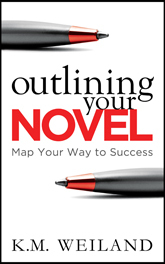
Outlining Your Novel (Amazon affiliate link)
Want to elevate your character development? Outlining Your Novel is the perfect guide to help you structure your plot and deepen your characters. It offers a plethora of tools for character development, including personality systems like the Enneagram. You can gain valuable insights into your characters’ motivations and growth, helping you create multi-dimensional figures that resonate with your readers. You can pair these frameworks with the outlining process in the companion workbook to craft compelling characters who feel real and dynamic. Start outlining your way to stronger, unforgettable characters today! It’s available in paperback, e-book, and audiobook
Wordplayers, tell me your opinions! Have you ever used the Enneagram for character development in your writing? What insights has it given you into your characters’ motivations and growth? Tell me in the comments!Click the “Play” button to Listen to Audio Version (or subscribe to the Helping Writers Become Authors podcast in Apple Podcast, Amazon Music, or Spotify).
___
Love Helping Writers Become Authors? You can now become a patron. (Huge thanks to those of you who are already part of my Patreon family!)The post Using the Enneagram for Character Development: Avoiding Repetition for Lies Each Type Might Believe appeared first on Helping Writers Become Authors.
May 12, 2025
Now on Audio! Next Level Plot Structure
Today, I’m thrilled to announce Next Level Plot Structure is now available on audio!
I’ve heard from so many of you who were hoping for an audiobook from the very beginning—as soon as the print and digital versions launched last summer. Big thanks for hanging in there and cheering it on! I truly appreciate your enthusiasm and patience!
(And if you’re wondering, an updated audio version for the second edition of Structuring Your Novel is also coming soon!)
You can now listen to Next Level Plot Structure on all major audiobook platforms:
AudibleApple BooksGoogle PlayKoboAudiobooks.comNo matter where you like to listen, it’s ready and waiting to join you on your next walk, drive, or writing session.
Also, don’t forget that if you’re not already an Audible member, you can grab the book for free just by signing up!
About the Audio BookElevate Your Storytelling with Expert Plot Structure
Unlock the secrets of compelling storytelling with Next Level Plot Structure, a new guide from K.M. Weiland, author of the popular Structuring Your Novel. This comprehensive resource delves deep into the intricacies of plot structure, revealing the rich vein of narrative techniques and philosophical underpinnings that have shaped storytelling throughout history.
Delve beyond plot beats to explore deeper symmetry and symbolism in story.Discover how every plot beat and scene is composed of two mirroring halves, contributing to the narrative arc.Introduce readers to chiastic structure, a mesmerizing mirroring technique that unites the two halves of a story.Master the dual beats of each major plot point to create dramatic scene arcs.Explore innovative ways to structure scenes to keep readers engaged and eager to turn the page.Examine the symbolic significance of a story’s four “worlds” and their influence on plot and character arcs.Evade formulaic story structures by understanding the deeper meaning and purpose of each plot element.Whether you’re a seasoned writer or just starting out, Next Level Plot Structure provides invaluable insights and practical techniques to help you take your storytelling to new heights.
Want More Audio?Check out all of my audiobooks:
Outlining Your Novel Structuring Your Novel Creating Character Arcs Writing Your Story’s Theme Writing Archetypal Character Arcs Conquering Writer’s Block and Summoning Inspiration 5 Secrets of Story Structure Dreamlander Wayfarer (full-cast production!)P.S. If you’ve already read Next Level Plot Structure and enjoyed it, I would so appreciate it if you’d leave a rating or review!
Wordplayers, tell me your opinions! What’s your favorite way to absorb writing craft info—reading, listening, or watching? And why? Tell me in the comments!The post Now on Audio! Next Level Plot Structure appeared first on Helping Writers Become Authors.
May 5, 2025
Want to Write Better Action Scenes? Cut This One Thing
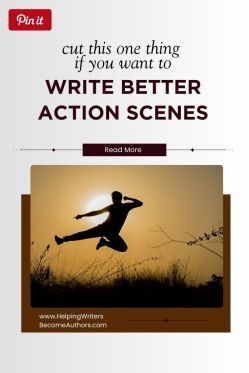
[From KMW: I’ve got a quick post for you today—a little storytelling snack—on how to write better action scenes. Specifically, we’re talking about what not to do if you want to keep your pacing tight and your scenes crackling with energy. (Hint: it’s all about trimming the fat, not the flavor.) I’ll be back next week with a full post and podcast on a juicy topic in response to one of your questions: “Using the Enneagram for Character Development: Avoiding Repetition for Lies Each Type Might Believe.”]
***
If you want to write better action scenes, the key isn’t just what you include—it’s what you leave out. Nothing kills momentum faster than a poorly timed info dump or an overstuffed description that stops the action in its tracks. Pacing is everything, and knowing how to control it can mean the difference between a scene that crackles with energy and one that fizzles before it even gets started.
You want readers to be sucked into the conflict so entirely they forget to close their mouths and stop drooling. You do this by deftly structuring the length and variables of sentences and by trimming unnecessary info that might slam the brakes on your runaway freight train of action-packed excitement. This is true no matter what type of “action” your story includes—whether it’s a chase scene, a love scene, or just an intense conversation.
One of the quickest ways to destroy any scene’s pacing is by interrupting the action with large chunks of description.
For Example:
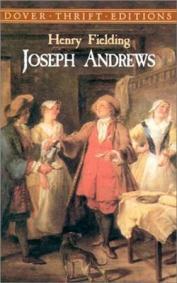
Joseph Andrews by Henry Fielding (affiliate link)
Henry Fielding’s satire Joseph Andrews (usually considered one of the first examples of the novel) acknowledges this problem, tongue in cheek.
During a tense and furious scene in which the hero helps a friend fight off a pack of attacking dogs, Fielding breaks the third wall to cheekily tell readers he would like to include a simile about now, but that he dare not interrupt the action, which he says “should be rapid in this part.”
In so explaining his reasons for not interrupting the action, Fielding, of course, brought the action screeching to a halt just as surely as if he had actually stopped to impart his simile. He was writing a satire, so he could get away with it. Most writers, however, cannot.
Writers often trick themselves into thinking descriptions are vital, when they very often are not. Just as Fielding’s action scene survived admirably without his simile, much of the information writers want to explain to readers often turns out to be deadweight.
The next time you find yourself wanting to slow down for description or explanation, double-check whether this info is vital. If you determine it is necessary, your next step should be reevaluating whether the info can be moved so it doesn’t interfere with the action. For example, if readers need this info to understand the action, make sure they’re privy to it before the bullets ever flying, the dogs ever start barking, and the train ever starts rumbling.
Trimming unnecessary description doesn’t mean stripping your scenes of depth or detail. It just means being intentional about where and how you include them. If you want to write better action scenes, focus on maintaining momentum by weaving essential details seamlessly into the flow, rather than dropping them in like roadblocks. If you keep the pacing tight, the action clear, and your readers engaged, your scenes will hit with the impact they deserve!
Wordplayers tell me your opinions! What are your favorite techniques to write better action scenes? Tell me in the comments!
The post Want to Write Better Action Scenes? Cut This One Thing appeared first on Helping Writers Become Authors.
April 28, 2025
The Most Dangerous Arc: Breaking Down the Corruption Character Arc
 In storytelling, few arcs are as gripping—or chilling—as the Corruption Character Arc. In this arc, characters don’t just fall, they choose to fall (although, of course, they don’t generally think of it like that). Whether driven by fear, pride, or desire, they trade their integrity for a Lie, believing it will give them what they want. Even when this is true, the cost is an ever-deepening descent into self-delusion and, often, self-righteousness.
In storytelling, few arcs are as gripping—or chilling—as the Corruption Character Arc. In this arc, characters don’t just fall, they choose to fall (although, of course, they don’t generally think of it like that). Whether driven by fear, pride, or desire, they trade their integrity for a Lie, believing it will give them what they want. Even when this is true, the cost is an ever-deepening descent into self-delusion and, often, self-righteousness.
In today’s breakdown, we’ll explore how to craft this final entry—and in many ways most insidiously dangerous—in the triad of foundational Negative Change Arcs. If you’re writing a story about a character who chooses the wrong path and justifies it every step of the way, this post will offer insights into creating a devastating Corruption Arc. Throughout this month, we’ve been looking under the hood of the three foundational Negative Change Arcs.
We’ve already explored how the Disillusionment Arc bridges the Positive Change and Negative Change Arcs by forcing characters through a revelation of the thematic Truth that is so powerful it is uncertain whether they will embrace it in a way that is ultimately redemptive or will succumb to the bitterness and resistance that can lead to ever-deepening negative spirals.
We’ve also explored the Fall Arc—in which characters refuse to take that journey into the Truth at all, instead doubling down on mistaken perceptions in a way that requires an initial Lie to be bolstered many times over with further Lies, leading the character to a much more benighted state than that of the beginning.
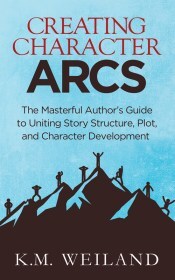
Creating Character Arcs (Amazon affiliate link)
Today, we culminate with the Corruption Arc, which presents as the mirror opposite of the Positive Change Arc. In a Positive Change Arc, characters will evolve their perceptions of themselves and the world from a limited Lie to a more expanded Truth. Oppositely, in a Corruption Arc, the character will begin in a relatively privileged and enlightened perspective, only to compromise this position through a failure in vigilance against the always present possibility of self-delusion. From there, they may well spiral ever deeper into the darkness.
In This Article:The Corruption Arc at a GlanceIt Starts With a Lie: The Moral Weakness at the Heart of the Corruption Character ArcThe Fall Within the Corruption: Trading Truth for PowerIn the End: Self-Delusion and the Mass Spread of the LieThe Corruption Arc At a GlanceCharacter Sees Truth > Rejects Truth > Embraces Lie
Graphic by Joanna Marie, from the Creating Character Arcs Workbook. Click the image for a larger view.
The First Act (1%-25%)1%: The Hook: Understands TruthThe protagonist lives in a Normal World that allows for or even encourages the thematic Truth. As a result, the protagonist starts out with an understanding of the Truth.
12%: The Inciting Event: First Temptation of LieThe Call to Adventure, when the protagonist first encounters the main conflict, also brings the first subtle temptation that the Lie might be able to serve the protagonist better than the Truth.
25%: The First Plot Point: Enters Beguiling Adventure World of LieThe protagonist is faced with a consequential choice, an enticement out of the First Act’s safe, Truth-based Normal World into the Second Act’s beguiling, Lie-based Adventure World. Not realizing the danger, the protagonist is lured through the Door of No Return by the promise of the Thing the Character Wants.
The Second Act (25%-75%)37%: The First Pinch Point: Torn Between Truth and LieThe protagonist is torn between the old Truth and the new Lie. The Lie proves itself effective in moving the character nearer the Want. But the character wages an internal conflict in moving further away from old convictions and understandings of the world.
50%: The Midpoint (Second Plot Point): Embraces Lie Without Fully Rejecting TruthThe protagonist encounters a Moment of Truth and faces the Lie in all its power. The character recognizes the Want cannot be gained without the Lie. Although not yet willing to fully and consciously reject the Truth, the character makes the decision to fully embrace the Lie.
62%: The Second Pinch Point: Resists Sacrifice Demanded by TruthThe protagonist is “rewarded” for using the Lie. Building upon what was learned at the Midpoint, the protagonist will start implementing Lie-based actions in combating the antagonistic force and reaching toward the Want. The Truth pulls on the character, demanding sacrifices too great to give. The character begins resisting the Truth more and more adamantly.
The Third Act (75%-100%)75%: The Third Plot Point: Fully Embraces LieThe protagonist utterly rejects the Truth and embraces the Lie. The character acts upon this in a way that creates a Low Moment for the world (and for the character morally, if not practically). The character is now willing to knowingly endure the consequences of rejecting the Truth in exchange for the rewards of embracing the Lie.
88%: The Climax: Final Push to Gain WantThe protagonist enters the final confrontation with the antagonistic force to decide whether or not the character will gain the Want. Unhampered by the Truth, the character pushes forward ruthlessly toward the plot goal.
98%: The Climactic Moment: Moral FailureThe protagonist uses the Lie in an attempt to gain the Want. The character may gain the Want and remain senseless to the evil engendered by these actions. Or the character may gain the Want only to be devastated that it wasn’t worth what was sacrificed. Or the character may fail to gain the Want and be devastated by the realization that the sacrifices to the Lie were fruitless. One way or another, the character definitively ends the conflict with the antagonistic force.
100%: The Resolution: AftermathThe protagonist must confront the aftermath of all choices. The character may turn away from the Lie, admitting mistakes and accepting consequences. Or the character may callously forge ahead, intent on continuing to use the Lie to further self-serving ends.
It Starts With a Lie: The Moral Weakness at the Heart of the Corruption Character ArcAll character arcs start with a Lie the Character Believes. This is a mistaken or limited perception of reality.
The Lie could be:
Simply a lack of information (e.g., how to overthrow the bad guy).An outright delusion (e.g., “I am the smartest person in any room”).A perspective held about one’s self that is either incorrectly positive or incorrectly negative (e.g., “I am a kind person” or “I am worthless”).An over- or underestimation of others (e.g., hero worship of a flawed leader or demeaning put-downs of certain people).An expectation of how the world works (e.g., “the deck is stacked against me” or “I deserve to have the rules bent for me”).Whatever the case, the challenge to this Lie catalyzes the beginning of every type of character arc—except the Corruption Arc. Instead, the Corruption Arc begins when a character is somehow tempted toward a more constrictive perspective. On the surface, of course, this doesn’t make sense. Why would anyone who consciously holds a relatively expanded perspective be foolish enough to willingly step into a more limited way of being?
The answer is as old as time and in many ways boils down to a Lie of its own: the characters believe they can use the Lie for their own purposes without allowing it to corrupt them. Hubris is always a factor.
Sometimes, hubris may be the main factor, in that characters feel so secure in their currently positive worldview that they believe they can risk taking a temporary step back into the shadows.
Other times, the primary motivator may be high stakes that cause characters to feel they are without choices; they understand they are not choosing an option that aligns with their integrity, but they choose anyway because they “have to” and because, again with a measure of hubris, they believe they can flirt with this seeming shortcut and still return with their integrity in tact. These characters make the fundamental mistake of believing that because they see some Truth, they are capable of seeing all of it. They believe they are capable of shining a light through the darkness they willingly choose to navigate in search of a treasure they need.
For Example:
Anakin Skywalker in Star Wars believes the Lie that power can prevent loss, leading him to embrace control as a moral justification. He also tends to conflate power with wisdom, overestimating his ability to wield power well.

Star Wars: Revenge of the Sith (2005), 20th Century Fox.
This is what makes the Corruption Arc one of the most complex character arcs. Why? Because daring the darkness in search of a healing treasure is also the heart of the heroic Positive Change Arc, in which characters risk everything—including integrity and perspective—to seek a better way of being. In essence, that is what Corruption Arc protagonists also do—or at least this is what they tell themselves they are doing. The difference is that when the character is presented with the choice between desire and Truth (i.e., power and integrity), the Corruption Arc character’s ability to recognize or honor the latter will increasingly fail.

Writing Archetypal Character Arcs (affiliate link)
The polarity of humility and hubris are present in both Positive Change and Corruption Arcs. Traditionally, Positive Change Arc characters (particularly Hero archetypes) start out with a certain measure of hubris (a form of the Lie), which they must exchange for humility as they progress the path. While Corruption Arc characters also begin with at least a hidden measure of hubris, they will end, at least in the abstract, in downfall and humiliation.
For Example:
Macbeth believes his destiny entitles him to power, which allows him to rationalize betrayal and murder.
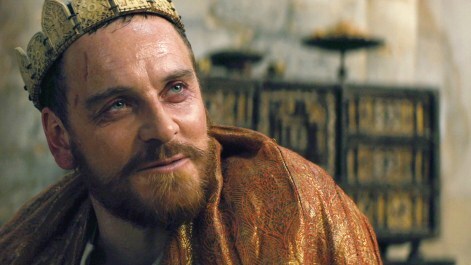
Macbeth (2015), StudioCanal.
Ultimately, what the Corruption Arc shows us is the high cost of failing to hold our previous successes—whether material or spiritual—with the type of humility that safeguards our gains against our own capacity for delusion and regression.
The Fall Within the Corruption: Trading Truth for PowerJust as the Disillusionment Arc can be recognized as an abbreviated Positive Change Arc (stopping short before it is clear whether the character will be able to integrate a harsh Truth into a greater good), the Fall Arc (which we discussed last week) can be recognized as an abbreviated Corruption Arc. In this case, the Fall Arc represents the latter part of the Corruption Arc, after characters have adopted the Lie and now must work double-time to bolster that Lie with even more Lies.
You’ll remember that the Fall Arc shows a character who refuses to accept the challenge of the Truth and from there devolves into a much worse Lie, all in an effort to protect that initial (often quite small) Lie.

Graphic by Joanna Marie, from the Creating Character Arcs Workbook. Click the image for a larger view.
The Corruption Arc begins before this point, revealing a character who likely has more mental or moral capacity for recognizing comparative Lies and Truths. This is a character who has achieved some level of personal integrity, which has now brought them to a place of testing. The central question is whether they will compromise their understanding of their own personal Truth (aka, their integrity) in exchange for a measure of power.
For Example:
Walter White in Breaking Bad begins manipulating, lying, and killing as he clings to power, convincing himself it’s for his family—when it’s really about ego.

Breaking Bad (2008-2013), AMC.
What always makes this invitation to power tempting is that it is, essentially, a shortcut. Whatever the practical mechanics of the plot, we know this is a shortcut on a character level because it prompts the character to take the “easy route” in defiance of a deeper sense of personal right and wrong. At some level, the Corruption Arc character will always know this, and in more nuanced stories, will often be shown to struggle with it. In short, they make an informed choice. They are not ignorant about what they are choosing. They understand it is against their deepest self, and they understand the possibility of untoward consequences to themselves, or more likely, to others. They do it anyway.
From there, the characters’ journey will begin to mirror the Fall Arc. In order to protect this one out-of-integrity choice, characters begin justifying their actions with an ever-deepening slide into delusion. From believing they “had no choice” or “no one would get hurt,” they will begin to adopt perspectives that insist “they were in the right” or even “they were acting in everyone’s best interest” or “they knew better than the ignorant masses.”
For Example:
Gollum in The Lord of the Rings slowly abandons his identity and humanity, letting the Ring reshape his very soul for the sake of possessing it.
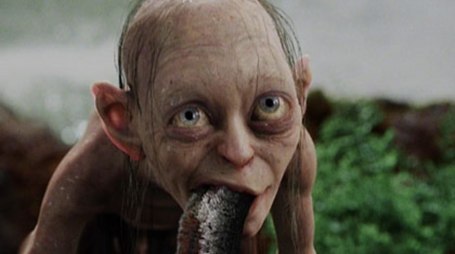
The Lord of the Rings: The Two Towers (2002), New Line Cinema.
In the End: Self-Delusion and the Mass Spread of the LieThe tragedy of the Corruption Arc is its excruciatingly slow slide away from wholeness into delusion. Corruption Arc characters very often end by achieving their goals. Thanks to the devil’s deal in which they sell their souls, they may well gain tremendous power and influence within their personal spheres. In the end, some characters may retain enough sense of their personal Truth to wake up to the horrors they have wrought in their own lives and others, in which case the victory for which they have sacrificed so much will prove horrifyingly empty. In other stories, characters will end by fully embracing their new Lie-based identity. Not only will they become the monster they initially believed they could resist, they may even fully condone what they have become.
For Example:
Michael Corleone in The Godfather exemplifies a Corruption Arc character who justifies his increasingly immoral actions by convincing himself they are necessary for protecting his family. He eventually becomes fully immersed in the darkness he once resisted. By the end, Michael’s self-delusion is so complete he not only believes his choices are justified, he also pulls others into his moral decay, perpetuating the destruction of those around him.
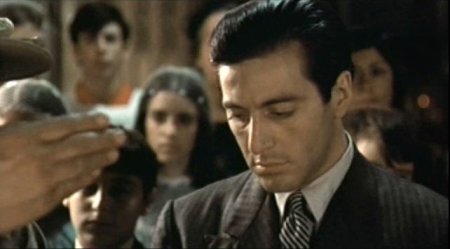
The Godfather (1972), Paramount Pictures.
Those Corruption Arcs that do not end with the characters achieving a redemptive sense of humiliation at what they have become will instead end with the character in a state of grotesque self-righteousness. They will justify their choices by any means necessary, no matter the consequences heaped upon others. Like the Fall Arc, the Corruption Arc character’s self-delusion in the end may be so complete and compelling that it also warps the perception of others, pulling them down into the darkness as well.
For Example:
By the time we meet President Snow in The Hunger Games, he’s wholly consumed by the belief that fear is the only way to ensure social stability. He’s convinced himself that this Lie is not only necessary but noble. He enforces it with ruthless propaganda, manipulation, and death. He’s not just corrupted himself; he’s built an entire system on his delusion.
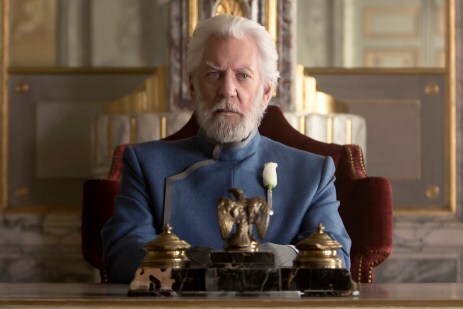
The Hunger Games (2012), Lionsgate.
***
The Corruption Arc reminds us that character arcs are not just about change but about choice. Of all the Negative Change Arcs, the Corruption Arc may be the most haunting. It doesn’t happen to the character; it happens because of the character. The central danger isn’t ignorance or even resistance to the Truth, it’s the conscious decision to turn away from it. When well-written, these arcs offer some of the most compelling, nuanced, and tragically human stories. As writers, exploring this arc challenges us not just to understand the psychology of our characters, but to confront the darker possibilities within ourselves.
In Summary:The Corruption Arc is a powerful exploration of a character’s conscious choice to embrace a Lie, despite knowing the Truth. Unlike the other Negative Change Arcs, which often involve ignorance or self-deception, the Corruption Arc is chilling precisely because it requires awareness. The character sees the Truth, but chooses not to follow it. This makes the arc uniquely tragic, as it dramatizes not just a character’s fall, but the moral failures leading up to it.
Key TakeawaysThe Corruption Arc centers on a character who knows the Truth but deliberately endangers it.This arc is defined by conscious moral compromise in pursuit of power, security, or other personal goals.The arc usually starts from a place of strength or clarity, making the fall more impactful.Unlike the Disillusionment Arc (which involves a painful but authentic awakening), the Corruption Arc is about the willful embrace of the Lie.This arc creates deeply human and emotionally resonant stories, especially when the character’s motivations are understandable or even sympathetic.Writing a Corruption Arc challenges authors to grapple with the complexity of choice, consequence, and morality.Want more?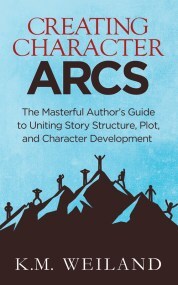
Creating Character Arcs (Amazon affiliate link)
If you’re intrigued by the emotional and thematic power of the Corruption Arc, you’ll find even more in-depth guidance in my book Creating Character Arcs. It walks you step-by-step through how to craft compelling transformations—Positive, Flat, and Negative—and how to seamlessly weave them into your plot. Whether your characters are resisting change or spiraling toward it, the tools inside will help you bring their arcs to life. It’s available in paperback, e-book, and audiobook (along with its companion guide the Creating Character Arcs Workbook).
Wordplayers, tell me your opinions! Have you ever written a Corruption Character Arc or considered one for your protagonist or antagonist? Tell me in the comments!Click the “Play” button to Listen to Audio Version (or subscribe to the Helping Writers Become Authors podcast in Apple Podcast, Amazon Music, or Spotify).
___
Love Helping Writers Become Authors? You can now become a patron. (Huge thanks to those of you who are already part of my Patreon family!)The post The Most Dangerous Arc: Breaking Down the Corruption Character Arc appeared first on Helping Writers Become Authors.
April 21, 2025
Writing a Fall Arc: How to Show a Character’s Moral Decline
 When writing a Fall Arc, writers get to explore the slow, often heartbreaking process of moral or emotional decline. In this type of Negative Change Arc, the characters’ refusal to change or acknowledge their flaws becomes a central theme. They hold onto a Lie—a deeply ingrained belief or limited perception of the world—that drives their actions and decisions. Over time, this self-deception evolves into something darker, affecting not just their own choices, but their relationships with others. Understanding how to write a Fall Arc can help you create a character whose downfall feels deeply tragic and engaging.
When writing a Fall Arc, writers get to explore the slow, often heartbreaking process of moral or emotional decline. In this type of Negative Change Arc, the characters’ refusal to change or acknowledge their flaws becomes a central theme. They hold onto a Lie—a deeply ingrained belief or limited perception of the world—that drives their actions and decisions. Over time, this self-deception evolves into something darker, affecting not just their own choices, but their relationships with others. Understanding how to write a Fall Arc can help you create a character whose downfall feels deeply tragic and engaging.
In some ways, the Fall Arc is the darkest of the three Negative Change Arcs. Although not as potentially redemptive as the Disillusionment Arc (which hints characters may continue their growth into a completed Positive Change Arc sometime in their future) or as tragic as the Corruption Arc (which offers the character a true chance of recovery that is refused and which we will discuss next week), the Fall Arc is still, for my money, the quintessential Negative Arc.
The Fall Arc offers an extraordinarily powerful window into the dark possibilities for devolution found within humanity’s tremendous capacity for self-deception. More than that, it reveals our almost primal willingness to defend that self-deception even at crippling personal cost, certainly on a spiritual level, but often on a practial level as well.
Inspired by ponderings from my own life, I wanted to revisit this fundamental character arc to explore some of the nuances of the character’s fall from grace. What creates this fall? Why are even intelligent and “good” people susceptible to this insidious degradation? And how can you craft Fall Arcs in your own stories that ring true to the patterns of real life? Let’s take a look!
In This Article:Writing a Fall Arc: At a GlanceThe Catalyst of a Fall Arc: The Character’s Refusal to ChangeThe “Worse Lie” in a Fall Arc: How Smaller Lies Protect the Character’s Self-DeceptionIn the End: Character’s Self-Deception Decays Into an Outward Deception of OthersWriting a Fall Arc: At a GlanceLet’s start with an overview of the arc itself. Like its brethren, the Positive Change Arc and the Disillusionment Arc, the Fall Arc begins with the Lie the Character Believes. From there, it deviates into darker and less redemptive territory, as the character proves willing to take whatever measures necessary to defend that belief—no matter how increasingly dysfunctional it may prove.
Character Believes Lie > Clings to Lie > Rejects New Truth > Believes Worse Lie
Graphic by Joanna Marie, from the Creating Character Arcs Workbook. Click the image for a larger view.
The First Act (1%-25%)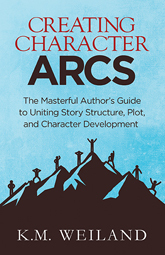
Creating Character Arcs (Amazon affiliate link)
1%: The Hook: Believes LieThe protagonist believes a Lie that has so far proven necessary or functional in the existing (often destructive) Normal World.
12%: The Inciting Event: First Hint Lie Will Not Save or RewardThe Call to Adventure, when the protagonist first encounters the main conflict, also brings the first subtle hint that the Lie will no longer effectively protect or reward the protagonist in the current circumstances.
25%: The First Plot Point: Lie Now Completely IneffectiveThe protagonist is faced with a consequential choice in which the “old ways” of the Lie-ridden First Act prove ineffective in the face of the main conflict’s new stakes. The protagonist is given an early choice between old Lie and new Truth. The character passes through a Door of No Return, which forces the character to leave the Normal World of the First Act and enter the Adventure World of the main conflict in the Second Act.
The Second Act (25%-75%)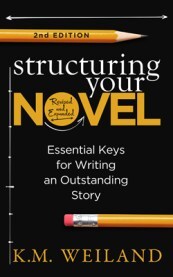
Structuring Your Novel: Revised and Expanded 2nd Edition (Amazon affiliate link)
37%: The First Pinch Point: Halfhearted Attempts at Truth Only Half-EffectiveThe protagonist may try to wield the Truth as a means of gaining the Thing the Character Wants, but does so only with limited understanding or enthusiasm. The character is stuck in a limbo-land where the old Lie is no longer a functional mindset, but where halfhearted attempts at the Truth prove likewise only half-effective.
50%: The Midpoint (Second Plot Point): Glimpses Truth, Rejects Truth, Chooses Worse LieThe protagonist encounters a Moment of Truth, coming face to face with the thematic Truth (often via a simultaneous plot-based revelation about the external conflict). This is the first time the protagonist consciously sees the full power and opportunity of the Truth. However, the character also sees the full sacrifice demanded in order to follow the Truth. Unwilling to make that sacrifice, the character rejects the Truth and chooses instead to embrace a Lie that is worse than the original.
62%: The Second Pinch Point: Lie Is Effective, But DestructiveUncaring about the consequences, the protagonist wields the Lie well and finds it effective in moving toward the Want. However, the closer the character gets to the plot goal, the more destructive the Lie becomes both to the character and the surrounding world.
The Third Act (75%-100%)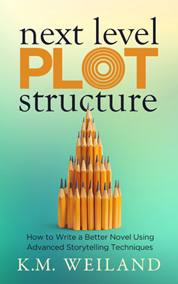
Next Level Plot Structure (Amazon affiliate link)
75%: The Third Plot Point: Complete Failure to Gain Either Want or NeedThe protagonist is confronted by a Low Moment, experiencing a complete failure to gain the Want. This failure is a direct result of the collective damage wrought by the Lie in the Second Half of the Second Act. The “means” caught up to the character before the “end.” However, even when faced by all the evidence of the Lie’s destructive power, the protagonist still refuses to repent or turn to the Truth.
88%: The Climax: Last-Ditch Attempt to Salvage WantUpon entering the final confrontation with the antagonistic force, the protagonist doubles down on the Lie in a last-ditch attempt to salvage the Want.
98%: The Climactic Moment: Total DestructionCrippled by the Lie (in both the internal and external conflicts), the protagonist is unable to gain the Want (or gains it only to discover it is useless). Instead, the character succumbs to total personal destruction.
100%: The Resolution: AftermathThe protagonist must confront the aftermath of all choices. The character may finally and futilely accept the inescapable Truth. Or the character may be left to cope, blindly, with the consequences of choices.
The Catalyst of a Fall Arc: The Character’s Refusal to ChangeLike the Positive Change Arc and the Disillusionment Arc, the Fall Arc character’s story begins when the protagonist is prompted to examine the limitations of the central Lie the Character Believes. Although this may be a literal deception in some senses, the Lie is most properly understood as a limited perspective. As such, it begins as an entirely normal and germane part of any human’s life.
For Example:
In Les Misérables, Inspector Javert’s inability to accept moral complexity leads him deeper into his own self-deception, ultimately making him incapable of seeing a world beyond his rigid belief system.
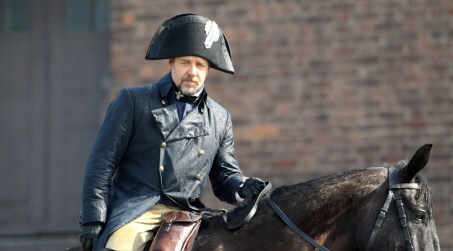
Les Misérables (2012), Universal Pictures.
We all hold countless limited beliefs. Indeed, arguably, all our beliefs about ourselves and reality are limited. To the degree we accept this and are willing to embrace change as new information and experience allows us to refine and expand those beliefs, this is simply part of the regenerative cycle of life. However, when this cycle is derailed by an unwillingness to accept corrections to our perception of reality, the result can be increasingly destructive for both the individual and, eventually, everyone in the vicinity.

Creating Character Arcs Workbook
Although Fall Arcs often look, at first glance, to be huge stories of great downfalls, they often have humble beginnings. The initial Lie the Character Believes will likely be something quite small and innocuous.
For Example:
The original Lie could be something as simple as refusing to accept responsibility in a relationship spat: “It’s not my fault.”
From there, characters who are truly doomed will find they must bolster this initial Lie with further arguments: “It’s her fault. I’m in the right. I’m righteous. I’m a victim. She’s selfish. She’s a narcissist. Etc.”
From here, the corruption can grow to truly staggering heights, as characters’ resistance to reality may even lead them to become the worst version of the very thing they are denying: e.g., the character becomes the narcissist.
Varying stories tackle this downfall to different degrees. Some may reveal the more mundane face of the Fall Arc, in which the character’s Lies are “small” enough not to interfere greatly with everyday functionality. In other stories, the character will be shown to fall all the way into the very pit of dark possibilities.
For Example:
In Nightmare Alley, Stan Carlisle begins the story as an ambitious, though morally compromised, man. He wants to climb out of his working-class roots and build a life of wealth and influence, but he’s driven by the wrong motivations: greed, ego, and a desire for status. At first, he tries to justify his actions, believing he’s in control of the people around him. However, his increasingly manipulative behavior, deceit, and manipulation spiral out of control, leading him further down a path of moral decay and self-destruction. His delusions of grandeur and the belief that he can outsmart everyone are his undoing.

Nightmare Alley (2021), Searchlight Pictures.
In either case, the Fall Arc reveals a deadly spiral. As the character devolves from Lie to worse Lie, the possibility grows ever greater that the spiral will continue with the character veering further and further into delusion.
The “Worse Lie” in a Fall Arc: How Smaller Lies Protect the Character’s Self-DeceptionFor simplicity’s sake, I refer to the end state of a Fall Arc character as the “worse Lie.” As you can see, however, what this worse Lie really amounts to are many “smaller” Lies eventually built into a grand illusion.
For Example:
In Black Swan, Nina begins with the small self-deception that she must be “perfect.” This Lie snowballs into a worse Lie: that she must destroy herself to achieve perfection, something that happens piece by piece and moment by moment throughout her story.

Black Swan (2010), Fox Searchlight Pictures.
Understanding this important nuance makes it possible to write a much more compelling and realistic Fall Arc. In real life, it is rare for a person to grandiosely self-delude except in situations of tremendous trauma or high stakes. Most of the time, the slide into delusion is the result not of one bad decision or perception, but of a continuing refusal to accept and confront reality.
The character may do this for any number of reasons. Almost always, those reasons amount to a primal need to protect the status quo. One of the great ironies of human life is that even though change is requisite for survival, our brains and nervous systems are wired to preserve the status quo at almost any cost. We do this not just to maintain the equilibrium our nervous systems desire, but also, by extension, to preserve the ego identities we use as coping mechanisms.
Not only are we are capable of believing in just about anything, but we also tend to incorporate those beliefs into our very identities—so that to challenge the belief feels like a threat to our very existence. This is why we appreciate heroic stories of Positive Change Arcs; they demonstrate the tremendous courage required to accept challenges to our beliefs, identities, and ways of being. In most instances, it is much easier to stuff away the cognitive dissonance whenever we are presented with a piece that doesn’t fit. It is easier to ignore the (millions) of nuances that challenge our tidy narratives every single day.
The catalysts that create stories of all types are those that interrupt a character’s life with such force that change becomes inevitable. Characters must either courageously face the catalyst and learn to expand themselves—or refuse the call and instead, inevitably, change negatively by increasingly restricting their view of reality and their capacity to expand.
For Example:
In Gone Girl, Amy Dunne begins her deception by crafting a small Lie—that she’s the perfect wife. Over time, this self-image morphs into a grander fabrication, where she not only deceives herself but manipulates everyone around her into believing her version of reality.
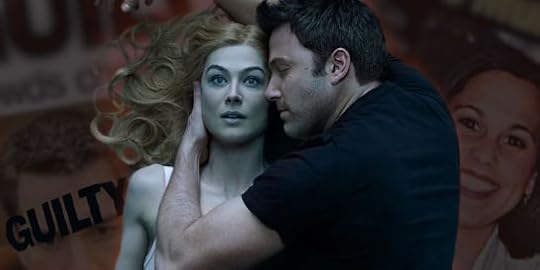
Gone Girl (2014), 20th Century Fox.
Powerful Fall Arcs show us the peril of refusing to claim courage and Truth. They also show, poignantly, how even the smallest of initial denials can eventually snowball into “worse Lies” that utterly crack an individual’s personal integrity.
In the End: Character’s Self-Deception Decays Into an Outward Deception of OthersIn the worst scenarios, the Fall Arc character’s warping of reality can become so insistent and powerful that it harms others. Sometimes, this can be the result of others being similarly deceived by the protagonist’s insistence that the Lie is, in fact, true. Most often, the negative effect will result from the protagonist’s unwillingness to maintain crucial integrity in relationship with, first, themselves, then others, then the world at large. Depending on the power the character wields, the effect of one character’s insistence on a Lie can have truly horrifying effects upon an entire community—or even the world, as witnessed in the demagogues of World War II.
For Example:
A media mogul obsessed with power and control, Kane in Citizen Kane starts off deluded by the belief that wealth and influence can buy love and happiness. His inability to confront emotional truths and his manipulation of public opinion leads him deeper into isolation. As he clings to a distorted version of reality, his relationships deteriorate, and his empire collapses.
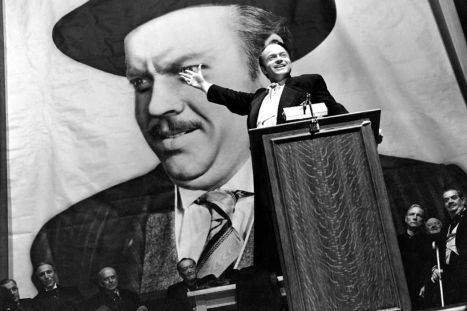
Citizen Kane (1941), RKO Radio Pictures.
How far you decide to take your Fall Arc will depend on the needs of your story. The effects can range all the way from characters who simply “miss the boat” because they lack the courage to hop on, to characters who severely limit or even destroy their lives, to characters who sway others into mass delusion.
In the end, the Fall Arc is a slow unraveling into self-deception. Characters cling ever more desperately to a Lie that will ultimately destroy them. The Fall Arc is a story of tragic inevitability. The character could have changed—but failed to embrace the courage of honesty before it’s too late.
Understanding this arc allows writers to craft deeply compelling character journeys that feel heartbreakingly true to life. The best Fall Arcs resonate because they reflect something deeply human: our resistance to change, our desperate need to justify our choices, and the ways in which small Lies, if left unchecked, can spiral into something far more destructive. Whether your character’s downfall is quiet or cataclysmic, mastering this arc can add powerful layers of complexity to your storytelling.
In SummaryThe Fall Arc is a Negative Change Arc that follows characters’ gradual descent into destruction as they cling to a Lie that ultimately undoes them. Unlike other Negative Arcs that allow for redemption or a conscious embrace of darkness, the Fall Arc is defined by missed opportunities for growth, making it one of the most tragic and compelling character journeys.
Key TakeawaysThe Fall Arc is a slow unraveling, marked by a character’s increasing self-deception.Unlike the Disillusionment Arc, there is no ultimate redemption.Unlike the Corruption Arc, the character is not making a conscious choice to embrace darkness, but rather resisting “the light” of a difficult Truth.The tragedy of this arc lies in the fact that the character could have changed but refused to.This arc reflects real human struggles—resistance to change, justification of bad choices, and the compounding consequences of small lies.Want more?If you’re fascinated by the darker sides of character arcs, check out my email course Shadow Archetypes: Writing Complex Fictional Characters. This course dives deep into the psychological underpinnings of morally gray characters, tragic figures, and antiheroes. Learn how to craft compelling, multi-dimensional characters who wrestle with their own inner demons.
Wordplayers, tell me your opinions! What challenges have you encountered when writing a Fall Arc? Do you struggle more with crafting the character’s moral descent, keeping them relatable, or nailing the ending? Tell me in the comments!Click the “Play” button to Listen to Audio Version (or subscribe to the Helping Writers Become Authors podcast in Apple Podcast, Amazon Music, or Spotify).
___
Love Helping Writers Become Authors? You can now become a patron. (Huge thanks to those of you who are already part of my Patreon family!)The post Writing a Fall Arc: How to Show a Character’s Moral Decline appeared first on Helping Writers Become Authors.




